Using Survey Research to Unlock Cultural Trends
Using Survey Research to Unlock Cultural Trends
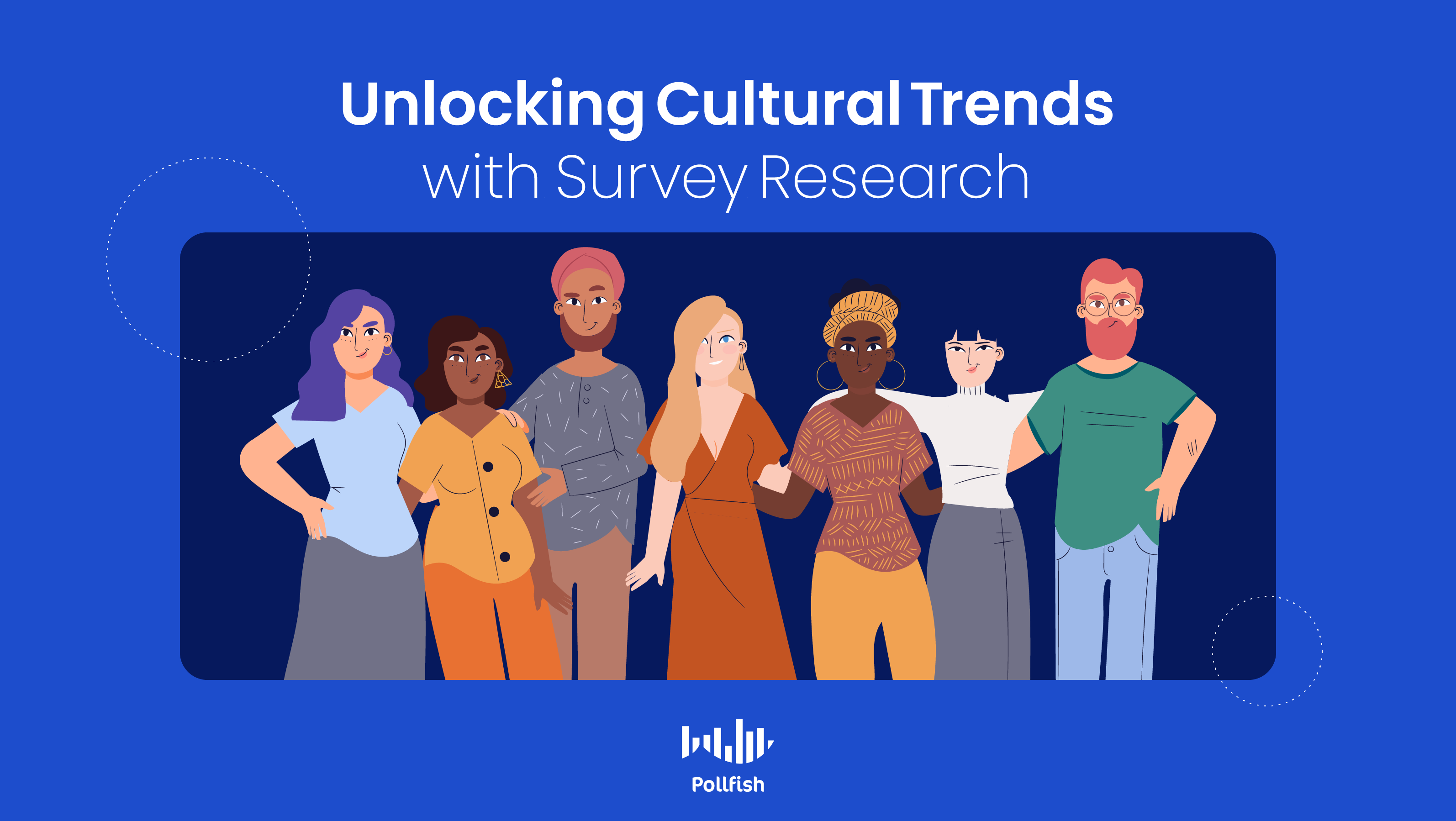
In order to stay adept at serving customers, brands must be attuned to cultural trends, whether they’re operating domestically only or marketing to customers abroad.
Our Global Customer Expectations poll revealed that almost a quarter of global customers seek brands that are more sensitive to the cultural aspects of their country.
Another supporting study found that brand involvement in cultural trends makes up a full 25 percent of a customers’ purchase decision. Evidently, brands have a stake in cultural involvement when it comes to satisfying their customers.
Unlike some of the more static aspects of marketing, cultural trends are, by nature, inclined to shift and fluctuate. Thus, the challenge becomes not merely discovering cultural trends but assuring their relevance and showing cultural deference.
This article delves into cultural trends, the need for businesses to be culturally competent and relevant, how surveys uncover various cultural trends and how to set up a survey to extract this information.
Understanding Cultural Trends
Cultural trends refer to popularized alterations and tendencies in culture, whether they are material or nonmaterial. These involve emerging or continuous behaviors, items and the relations of both. For example, product use; some trends involve using products in a particular way or for a particular act.
Cultural trends can also specifically apply to the dominant or emerging cultural aspects present among different cultures. This is a matter of concern for businesses that operate both internationally and domestically, as customers expect businesses to understand cultural matters that pertain to their country — as our survey found — along with others.
For example, a study by Salesforce found that 66% of customers expect companies to understand their unique needs and expectations, yet 66% also say that they are treated like numbers. Additionally, 52% of customers expect offers to always be personalized.
Understanding cultural differences and trends is crucial in each case. In regards to the former, understanding cultural practices and other concerns is crucial to make customers feel distinguished and as more than just another number being marketed to.
Regarding the latter, personalization cannot be fully achieved without paying attention to cultural matters. In fact, companies may incur issues when trying to personalize, by not taking into account cultural differences.
Businesses must also take heed to the cultural trends present within their country, as it is a means of staying relevant. Some cultural trends align with certain values, which is crucial to include in marketing campaigns. This is because 71% of customers prefer buying from companies aligned with their values.
Understanding cultural trends is key for market research, especially if a brand uses its name in its research; it is also important for a wide breadth of marketing campaigns.
The Importance of Cultural Trends
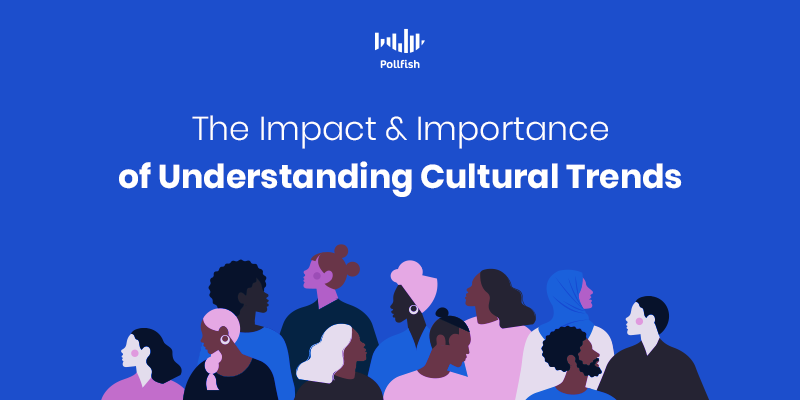
To piggyback off of the previous section, understanding cultural trends is a must for various reasons. The two main reasons deal with domestic and international customers. However, they also apply to dealing with employees, vendors and partners.
On the international front, few businesses can evade the need to deal with foreign clients, customers and employees. Given that the world is globalized and global markets open new opportunities, businesses would be at a disadvantage not to branch out into new geographic markets.
In order to properly cater to the international market, businesses must be acquainted with cultural trends across geographies, especially those that pertain to specific countries.
Cultural change is broader than social change, although it can include it in its sphere of influence. As such, societies and their markets are the results of culture. It is a culture that sets boundaries, limits and dictates what is acceptable or not. Thus, businesses must be in tune with the culture of the market they wish to pursue.
Understanding cultural trends is the gateway into cultural competence, the ability to effectively interact, work, and develop meaningful relationships with people from various cultural backgrounds.
Cultural competence allows brands to ease into different geographic markets, as it makes global customers feel understood and heard, a key tactic to ward off making them feel like just another number.
Understanding cultural trends also helps businesses avoid cultural misunderstandings, the kinds that directly cause businesses to lose customers and tarnish their reputation. This can get to a bad enough point in which a business’s harmless misunderstanding makes the news, a blow to brand equity and reputation.
Finally, being culturally competent is necessary for conducting business domestically, as customers are more likely to buy from brands that incorporate timely cultural aspects into their marketing and business at large (as proven in the intro).
Incorporating cultural trends domestically posits a business as more culturally savvy than its competitors. Additionally, it speaks directly to some of the thoughts occupying customer’s minds.
Moreover, the US and many other countries have significant immigrant populations; thus it is imminent for companies to be in contact with people of other cultural backgrounds, whether they are customers, employees, partners, vendors or clients. Thus, it is key to be in the know of all the cultural trends of your target market.
How Surveys Help Discover All Kinds of Cultural Trends
Surveys are a tool that opens many doors into the minds of customers, and customer satisfaction is a prominent objective to keep any business afloat.
Firstly, surveys define a business’s clientele; this is done via market segmentation, in which market researchers granularly define their target market by segmenting into different groups. This helps businesses learn the demographics of their most valuable customers.
Through this practice, businesses uncover the ethnicities, cultures and national backgrounds of their targeted customer segments. This allows businesses to zero in on particular cultural trends: those that are most relevant to the segments of their target market, specifically the most valuable segments.
Furthermore, surveys allow brands to delve into virtually any topic of their choice and understand it at an in-depth level. Thus, they can do so by creating surveys that delve into their target market’s cultural trends.
Surveys, especially the online variety, provide the ease of deploying questionnaires to a business’s intended audience. Most conveniently, online surveys are completely anonymous, so respondents can freely provide answers on all cultural matters, even those that are more sensitive in nature.
Businesses can cover various cultural matters in just one survey, though longer surveys should provide survey incentives to guarantee participation. Businesses can also set up survey campaigns that include multiple smaller-length surveys that cover various topics within cultural considerations.
Surveys have the power to generate both quantitative and qualitative market research, depending on how the questions are set up. Multiple-choice questions lend themselves to quantitative data, while open-ended questions allow businesses to gain qualitative data unique to each survey respondent.
Either way, businesses can gain both kinds of data within just one survey. To do so, they can ask a multiple-choice question and follow it up with an open-ended question.
Survey Questions that Unlock Cultural Trends
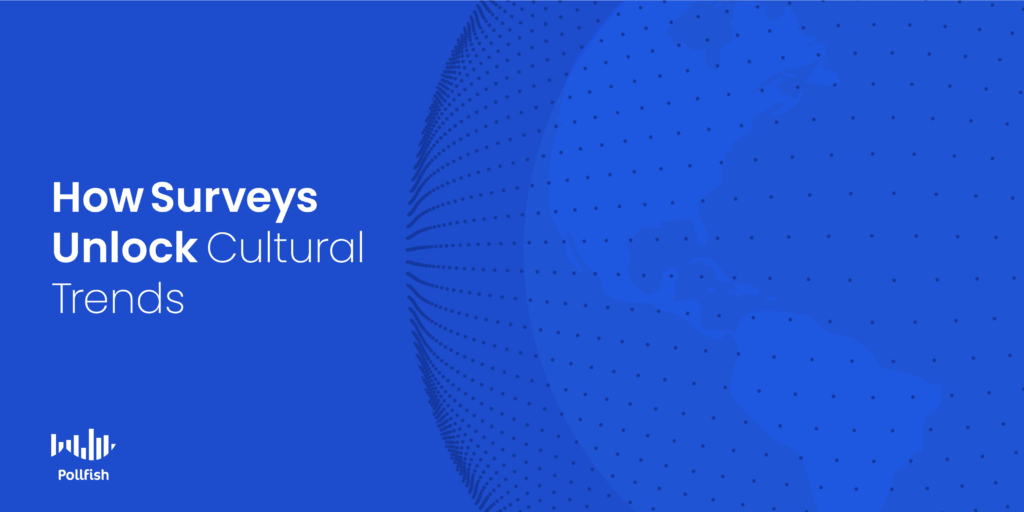
The questionnaire is the heart of a survey; therefore, brands must arrange it strategically to set their survey up for success.
They should also target respondents differently per country in the screening portion of the survey. After choosing the customer segments to target, researchers need to create their questionnaire accordingly.
Because all countries, even those that appear to be culturally similar, have distinct cultures, market researchers should focus on specific questions per country. However, before veering into the specific, there are certain general questions that researchers should begin with as a best practice.
The following provides question examples on the preliminary questions market researchers can use in their cultural trends survey before delving deeper:
- What is the biggest cultural change you’ve seen [country name] undergo?
- Multiple-choice and open-ended answers
- How do you feel about [a cultural event, major recent occurrence, trend observed via secondary research] ?
- Scaled and open-ended answers
- Which brands do you use for [a particular need]?
- Multiple-choice, multiple-selection answers
- Do some research on the brands from a particular country
- What would be considered rude coming from a company in your country?
- open-ended answer
- What are some of the biggest trends in [your niche] in your country?
- Multiple-choice and open-ended answers
Being In Tune With All Customers
A lack of cultural awareness has grave costs on businesses. That’s why virtually all businesses must be culturally aware within their domestic and international markets. The latter is especially important in the age of the internet, where global customers may discover a brand digitally, therefore opening the doors for businesses to venture into global markets.
While surveys are a convenient method to uncover cultural trends and differences, they are only as useful as the online survey platform that administers them. A strong online survey platform must be able to facilitate all stages of the survey process: from the screener, to the questionnaire, to deployment and finally, filtering data after the survey completes all of its quotas. Additionally, a strong survey software uses artificial intelligence to perform quality checks that remove gibberish answers, flatlining and other poor data to ensure the highest quality of customer data.
Businesses should opt for such a platform to not simply obtain cultural trends information, but to engage in a valuable market research campaign.
Understanding Customer Value and How Businesses Can Generate It with Surveys
Understanding Customer Value and How Businesses Can Generate It with Surveys
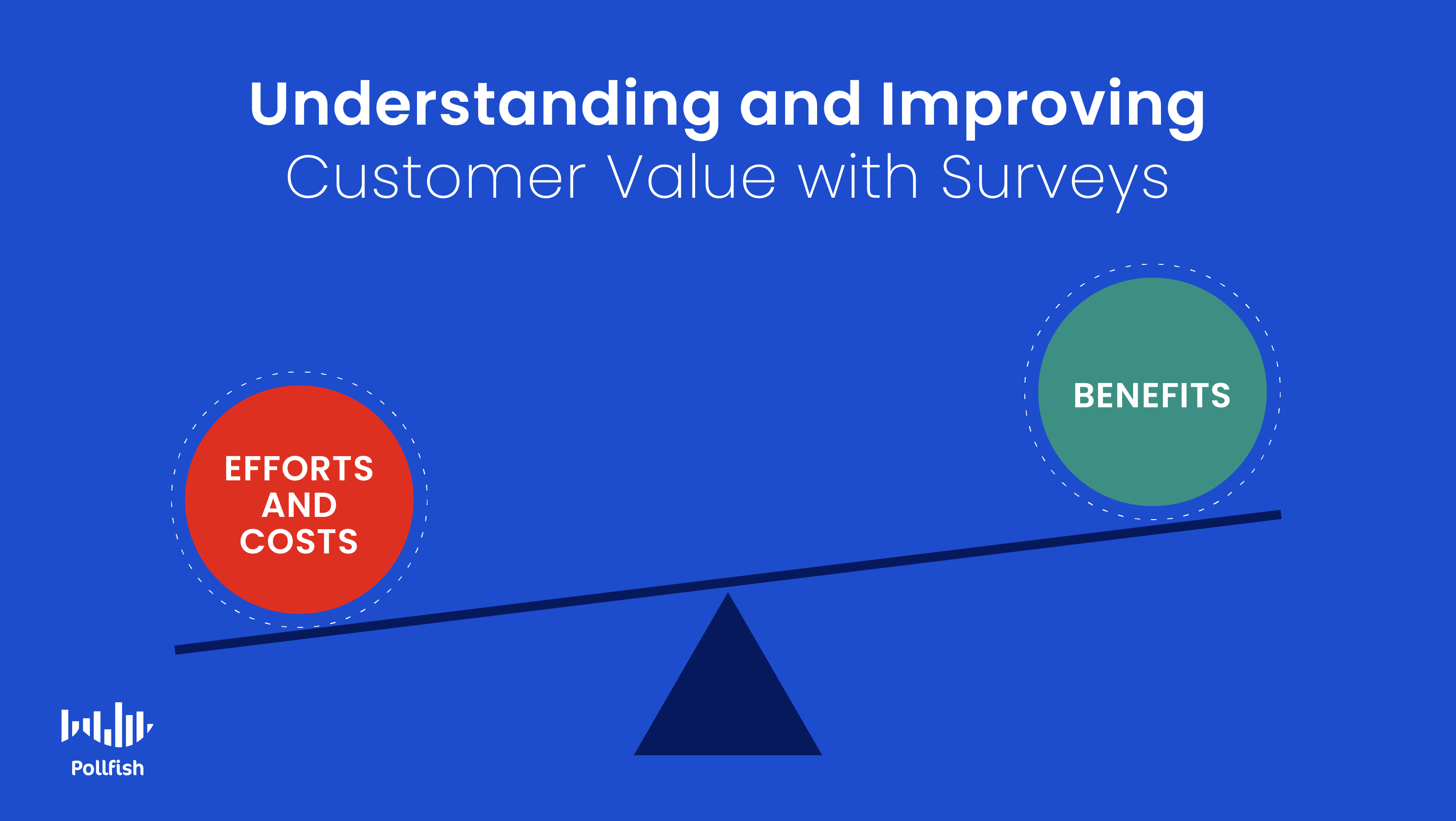
Customer value is a key aspect for acquiring, developing and retaining customers. Businesses would be remiss not to work on improving it to sustain profitable customer relationships.
Contrary to its name, it does not signify the value that a customer brings to a business — which is not to say that customers don’t carry value. Rather, customer value denotes the satisfaction a customer experiences or expects to experience by taking an action relative to the cost of that action.
Businesses must provide this value, as over 65% of customers globally believe it is very important for businesses to understand their unique needs and expectations. When a business properly serves its target market, then its members derive a higher customer value.
In turn, this makes a business more competitive and better positioned to develop customer satisfaction and build customer loyalty.
This article explains the concept of customer value, its importance, how to calculate it, how surveys can improve it and more.
Understanding Customer Value
Also called customer-perceived value, this concept is defined by the perception of what a product or service is worth to a customer versus its possible alternatives.
More specifically, it entails the benefits a customer derives from a service or product in relation to the customer’s costs, which include all the efforts and difficulties they face when obtaining or using a product or service.
In short, this measurement explains whether a customer feels they received benefits over the price that they paid.
In this regard, “paying” does not simply refer to prices such as one-time and subscription costs, fees, interest, etc. Instead, it also includes non-price aspects, such as providing their effort, energy, time, data and other inconveniences.
In addition, payments do not necessarily refer to purchases; they can also mean store visits, sign-ups, content downloads and more.
The benefits in customer value denote the advantages or quality of a product, service, image and the brand equity of a company, along with a good customer experience (CX), values, the success a customer experiences from using a product and so on.
Businesses can heighten their customer value when they augment their core competencies and other drivers of value to better serve all customers’ needs and concerns.
The Importance of Customer Value
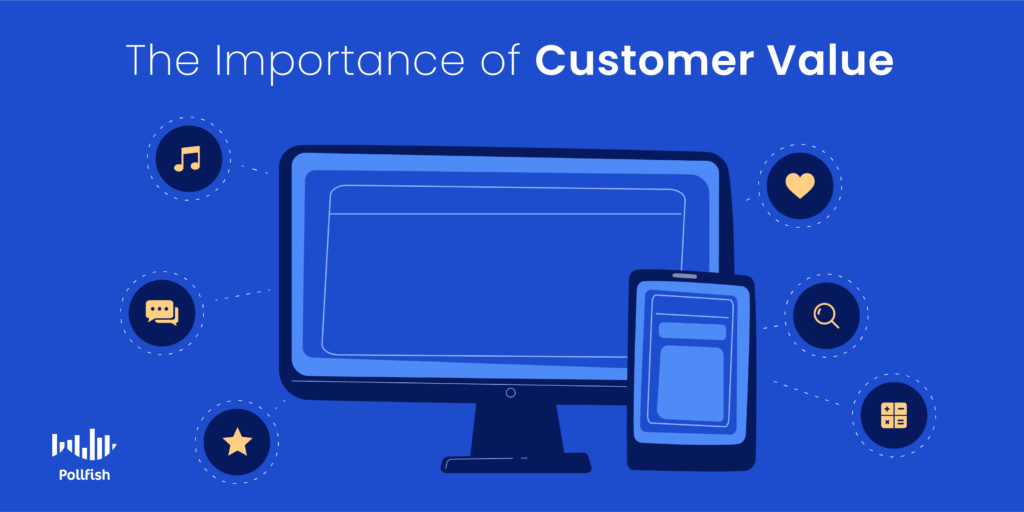
Customer value is important for businesses for many reasons.
Firstly, customer value increases both the customer experience and customer satisfaction. CX plays a major role in the long-term success of brands, as 74% of customers are likely to buy based on customer experience alone. Experience-driven businesses also see a 1.5 times higher YoY growth in repeat purchases and customer retention, a necessity for maintaining a business’s customer base.
The reverse also occurs, as a good customer experience creates customer value.
As for customer satisfaction, it is especially important for a business, as unhappy customers churn, while satisfied customers stay and are far more likely to become repeat customers. Thus, satisfaction drives loyalty, thereby upholding customer retention. Customer value is largely involved with satisfaction, as satisfied customers drive some sort of value, while dissatisfied customers either don’t or gain very little from their transactions and engagements with a business.
Customer value also forges customer advocacy, in which the customers themselves act as marketers for a company. Customer advocates recommend the companies that bring them value, thereby spreading brand awareness, fostering a positive brand image and essentially providing free marketing services. Customer advocates spread their messages across social media, review websites, forums, blogs (if they have them) and also produce word-of-mouth marketing. This can attract many new leads and conversions.
Additionally, customer value steers sales forward, as it creates a sense of urgency for customers, prompting them to not simply buy but to buy sooner. By forming timeframes for key value-building benefits to the customers, such as increased efficiency, lower downtime, better quality, and many more value points, customers will be much more drawn to purchase from a business in a timely manner. In turn, sales workers can close sales quicker.
Finally, while it may seem to be a stretch, creating customer value contributes to a business’s market share — the percentage of a total market a business controls for its products and services. A higher market share allows businesses to operate on a greater scale and increase their profitability. This occurs when businesses provide as much customer value as possible, such as pricing convenience, useful products and many other factors.
How to Calculate Customer Value
Although customer value includes intangible items in addition to tangible ones, businesses can still measure it to understand the value their customers derive from their business. First, businesses must consider all the factors that make up the two main variables in customer value: benefits and costs.
When compiling all of these factors, businesses must identify the most relevant ones in relation to their business and for their customers. The reason behind this is evident, given that businesses have different value propositions, offerings, prices and so on.
Although the calculation for customer value is simple, the many factors behind its two variables render this calculation more of a rough estimate, than a hard and fast metric.
The following lays out the various components of customer benefits and costs:
Total Customer Benefits:
- Product benefit
- the problem a product solves
- ease of onboarding
- Service benefit
- service convenience
- Experience benefit
- ease of use
- Personal benefit
- social status
- Image/branding benefit
- brand reputation
Total Customer Costs:
- Monetary costs
- Tangible
- The price of a product or service
- Installation or onboarding costs
- Renewal costs
- Tangible
- Time costs
- Intangible
- Time invested in buying a product or service
- Time invested in learning how to use a product
- Intangible
- Energy costs
- Tangible
- Installation or onboarding costs
- Maintenance costs
- The cost of accessing your product or service
- Renewal costs
- Intangible
- Time spent understanding how your product or service works
- Physical commitment
- Tangible
- Psychic/emotional costs
- Tangible
- The cost of accessing your product or service
- The cost of using a service/product with issues
- Intangible
- A poor customer experience
- Physical or emotional stress induced from buying or installing your product
- A poor brand reputation
- Tangible
Businesses must bear in mind that because this calculation includes tangible and intangible elements, the customer value formula won't look like a typical mathematic calculation.
You'll need to specify how much benefits are worth in comparison to the costs customers incur, such as time investment, emotional stress, and more.
Customer value is also going to vary depending on the customer segments you analyze. Since each segment, customer persona and individual customer is different, they’ll have particular needs, expectations and goals.
As such, they’ll have customer values, along with different standards of good and poor value. Businesses should therefore conduct market segmentation, identify personas and calculate the customer value for each segment and persona.
The Customer Value Formula
After you consider all the possible benefits and costs associated with your business or particular product or service, and have narrowed down the most relevant, you’ll need to plug them into the customer value formula.
Use the following formula:
(Total Customer Benefits - Total Customer Costs) = Customer Value
(B - C = CV)
How Surveys Help Improve Customer Value
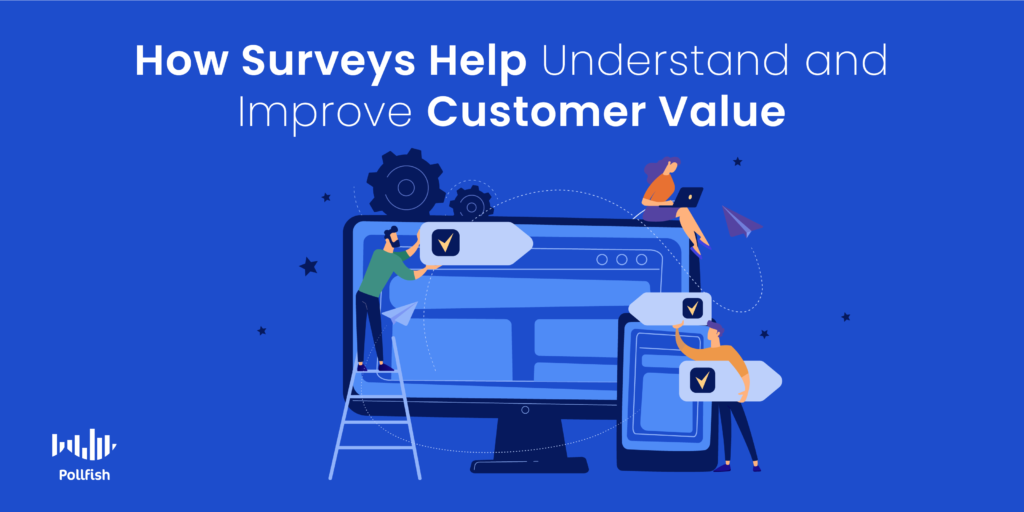
Online surveys provide a method that goes far beyond understanding a target market, or any group of customers. It can significantly improve customer value. Here’s why:
Brands should consider that when they sell a product, the utility of that product usually doesn’t change among customers. However, although its functionality remains the same, customer value will waver, as customers find value in different aspects of a product.
Surveys give businesses a firsthand approach of understanding what they consider valuable and what tarnishes that value for them. Adding to this, surveys can be set up in a number of ways, allowing business to both measure and gain specific customer data.
With online surveys, businesses can segment their customers and identify personas, as surveys are potent tools for market segmentation. In addition, online surveys grant businesses the ability to target their most loyal customer group.
Thus, surveying allows them to understand the makeup of their target market more precisely and study the most valuable subsets of customers.
There are also numerous kinds of customer satisfaction surveys, such as the net promoter score, or NPS survey and the customer effort score, or CES survey. The CES survey is particularly relevant to customer value, as it measures customer effort, one of the costs and variables of customer value.
Businesses should also consider that customer needs change throughout the customer journey and especially during a customer lifecycle. The customer journey includes pre-sales purchase intent, the browsing, the actual purchase, the installation, the use of a product or service and post-sales events. Thus, what they prioritize in terms of value is constantly changing.
Surveys allow companies to keep track of those changes, whether it is via brand tracking, brand visibility, changes in customer loyalty and more. Surveys can be deployed through various stages in the sales process making it easy to detect changes and consistencies in what customers perceive to be valuable about a business and its offerings.
Additionally, surveys allow businesses to evaluate how different customer segments feel about their pricing in a simple way. This is important to customer value, given that price is one of the major costs associated with customer value and a general customer pain point. All answers remain anonymous, which allows customers to be honest about how they feel about prices.
Forging Value Across All Offerings
In summary, businesses ought to pay careful attention to their customer value, as it dictates how customers perceive a brand in terms of its value to them. It is evident that businesses with low customer value will inevitably lose customers, while those with high customer value will retain and acquire customers.
Online surveys provide a quick and efficient way for businesses to understand and improve their customer value, as surveys gain insights on all the factors and variables of this notion. They can show where businesses are lacking, how they can improve and most importantly, what it is specifically that customers want and need.
However, not all online survey platforms offer the same functionalities and efficiencies. Businesses must therefore invest in a strong online survey platform, one that makes it easy to create and deploy surveys.
Additionally, they should opt for providers that offer high-quality data, such as RDE (random device engagement sampling) to net respondents in their natural digital habitats in a completely randomized way, as well as include artificial intelligence that performs quality checks that ensure the highest quality of customer data.
When an online survey provider offers all of these functionalities and customer service around the clock, businesses are poised to gain valuable insights on customer value, raise it and are generally in good hands for all other customer data needs.
Understanding the Customer Churn Rate and Using Surveys to Lower It
Understanding the Customer Churn Rate and Using Surveys to Lower It

The customer churn rate is a crucial metric that all businesses must measure, as customer churn is a grim reality that businesses contend with regularly. In fact, two-thirds of companies have a customer churn rate above 5%.
Also referred to as customer attrition, defection or turnover, this metric gauges the unfavorable aspect of the loss of business with customers, users, vendors, revenue, or other factors within a period of time.
Commonly used in SaaS market research, it is used to measure the percentage of customers who unsubscribe from a SaaS product in a given period of time. However, this metric is crucial to measure in all industries.
This rate ought to be kept low, as churn usually indicates customer dissatisfaction or the availability of affordable alternatives. This is hugely problematic, as the customer is king; 43% of customers spend more money on brands they're loyal to. Additionally, acquiring a new customer costs 5 times more than retaining an existing customer. Thus, businesses should retain their loyal customers.
This article expounds on the customer churn rate, its importance, its average across various industries, its calculation and how surveys can lower it.
Understanding the Customer Churn Rate
As its name suggests, this rate is a calculation of customer churn. Before diving into the metric, businesses should understand the meaning of customer churn.
Customer churn refers to the number of customers or subscribers who stop using a service during a given time period. There are a number of ways that customer churn affects a business, depending on its nature. These include:
- An account closure
- A subscription cancellation
- A non-renewal of a contract or service agreement
- A consumer switching to another service provider
- The cancellation of a contract midway through it or before completion
The customer churn rate (CCR) is therefore a metric that calculates the total number of customers a business has lost during a specific period. Therefore, it is the antithesis of the customer retention rate.
The customer churn rate is typically used to measure churn in businesses that run on a contractual or subscription-based product or service offering. As such, this term is chiefly associated with companies that operate on a subscription basis, such as SaaS companies.
referred to as the proportion of contractual (or subscribed) customers who terminate their contractual relationships/subscriptions with a company in a given timeframe. In this context, the term is primarily associated with companies operating on a subscription basis.
The Importance of the Customer Churn Rate
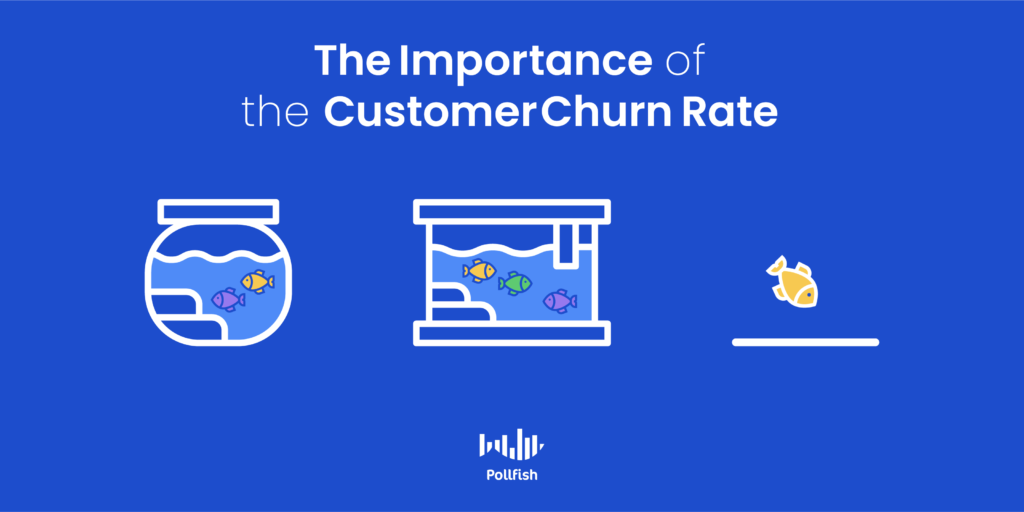
Businesses should measure their customer churn rate at regular intervals, as it is an important metric.
Firstly, its indication of lost customers directly ties into lost revenue. When a company loses customers, it negatively affects its bottom line. In this way, a high churn limits a business’s growth potential. Additionally, a significant churn rate always incurs financial difficulties of some degree.
Another reason it is so important to study and improve customer churn is that it is far more expensive to acquire new customers than it is to retain existing ones. In fact, acquiring a new customer costs 5 times more than retaining an existing one. As such, a business’s customer acquisition cost (CAC) is going to be more expensive than its customer retention rate (CRR).
Therefore, when a business loses existing customers, it will have to grapple with both the loss of revenue and business opportunities, coupled with the need to spend more on acquiring customers to make up for those that have churned.
As such, businesses must rein in their customer churn rate — and in order to do so, they have to keep track of it.
Studying this rate also involves keeping tabs on the competition, another critical area of maintaining business success. This is because the CCR can increase when competitors launch new and/or less expensive products, which may entice customers to churn and switch to them.
This dampens customer loyalty for obvious reasons and for some customers, can be a permanent switch to another brand. The ability to predict the churn rate is necessary for a company’s long-term success. Thus, businesses should gauge their churn rate and control it whenever possible.
How to Calculate the Customer Churn Rate
There are multiple ways to calculate the customer churn rate. This metric is typically presented as a percentage of either lost revenue or customers lost within a period of time. The following explains the CCR calculation:
To calculate a company's churn rate, first, you must choose a period of time to evaluate and identify the following values:
- The number of customers at the start of a period (X)
- The number of customers lost during the period (Y)
Then, use the following churn rate formula to determine your customer churn rate (Z), expressed as a percentage.
Customer Churn Rate Formula
CCR = (Y / X) x 100
CCR = (number customers churned in a period / number of customers at the beginning of the period) X 100
For example, if a business had 200 existing customers at the start of Q3 and lost 20 customers by the end of Q3, it would calculator its churn rate as such:
CCR = (20/200) x 100
CRR = 0.1 x 100
CRR = 10%
This means that this business has a quarterly customer churn rate of 10% for Q3.
Aside from the number of lost customers, there are other churn metrics to plug into the customer churn rate formula. Whether or not these metrics are worth using to calculate the CCR is completely up to the business in question. It will depend on the nature of the business and its performance metrics needs.
Other churn metrics that businesses can use include the following:
- recurring revenue lost
- percentage of customers lost during a specific period
- decreased engagement product engagement
- percentage of revenue lost
- other variables specific to their product and business.
The more granular a company is with its customer churn analysis, the more effective it can be when working to reduce the churn rate and keep its customers.
Ideal Versus Poor Customer Churn Rate Benchmarks
All businesses undergo churn, even those that are new and/or are experiencing a solid subscription rate with no current turnover.
How can businesses distinguish between a good and bad churn rate? There are certain existing benchmarks for this. The most ideal, but unrealistic churn rate is 0%, as no business profits when a customer churns.
Given that it is virtually impossible to maintain a 0% churn rate, there are certain practical benchmarks that businesses can aim for. The following lists both ideal and poor CRR benchmarks that businesses ought to know:
- The ideal churn rate is 5-7%.
- This is considered the proper rate for mature and well-established SaaS companies that target enterprises.
- For early-stage businesses, the monthly churn should be closer to 5%.
- A churn rate above 10% is a critical warning that a business is poorly faring in customer retention.
- It signifies the need to change the customer experience (CX).
- A high CCR is over 10%, signifying that a business is operating at an unsustainable rate.
- It usually means that marketing efforts/ resources are used for acquiring customers rather than retaining them.
- When a business has a high churn rate, it must examine how it forms and fosters its customer relationships.
The Customer Churn Rate Across Industries
The CCR varies across industries and is highly likely to vary from one company to the next. Businesses should have an overview of how the churn rate fares in their industry and others. The following lists the average customer churn rate across several major industries:
- General retail: 24%
- Online retail: 22%
- Financial: 25%
- Telecommunications: 21%
- Travel: 18%
- Big box electronics: 11%
- Cable: 25%
- SaaS: 4.79%
How Surveys Can Lower Customer Churn Rate
Survey research can be used for a variety of purposes, which include lowering this unfortunate metric. This is because reinforcing strong business relationships with customers is a must in order to decrease the CCR. The most potent way to achieve this goal is by understanding your target market. Surveys allow businesses to do so in a quick and efficient manner.
Surveys allow businesses to examine their customers on an in-depth level, as surveys provide them with anonymity and speed, unlike survey panels and focus groups, which are not anonymous and are typically more time-consuming.
Given that surveys can address a wide range of topics, from customer satisfaction, to customer aversions, to customer buying behavior, brands can gain a wide swath of insights that support various campaigns.
Whether a business seeks to adjust its pricing strategy, partake in customer development before releasing a new product or improve its brand visibility, surveys provide the strongest means for obtaining customer feedback and insights.
Essentially, surveys allow businesses to understand their customers in relation to numerous business topics and concerns, while also providing them the opportunity to improve their strategies across functions, such as marketing, advertising and beyond. When businesses are in lockstep with their customers, they are far less likely to disappoint them.
Thus, businesses that know how to cater to their customers are poised to satisfy and delight them, thereby lowering their customer churn.
Using the Best Online Survey Platform to Reduce Churn

Customer churn can occur within even the most loyal of customers, especially in a highly competitive landscape. Understanding what causes formerly loyal customers to abandon ship is much-needed to sustain business growth.
While survey research is crucial, all online survey platforms are not identical in function, interfaces, data quality and ease of use. A strong online survey tool ought to excel in all regards and more.
For example, a useful online survey platform should incorporate RDE (random device engagement sampling) in order to capture respondents in their natural digital habitats and in a completely randomized manner, as well as include artificial intelligence that performs quality checks to ensure the highest quality of customer data.
Businesses should choose their survey software wisely, should they seek to lower their churn rate and improve on many other business fronts.
How to Perfect an In-Home Use Test (IHUT) with Survey Research
How to Perfect an In-Home Use Test (IHUT)with Survey Research
An in-home use test is a critical form of market research, particularly for product testing, product development teams and businesses that have yet to launch a product to market.
While market research may appear non-experimental outwardly, there are several kinds of testing necessary to conduct, such as experimental research and in product testing specifically, customer development.
An in-home use test complements the experimental aspect of market research and allows businesses to understand the viability of their product from their customers themselves.
This article expounds upon the in-home use test and illustrates how survey research can perfect it so that you fulfill your market research techniques.
Defining the In-Home Use Test
This kind of research is a critical method in product testing, in which businesses measure the performance of products and their effects on customer satisfaction.
Also called the home usage test or in-home user test and abbreviated as the HUT or IHUT, this form of market research refers to the testing of a new product by way of sending it to a customer's home rather than sending the customer to a facility to try the product.
This way, businesses can understand how customers will use their products as they normally would — in their natural home environments.
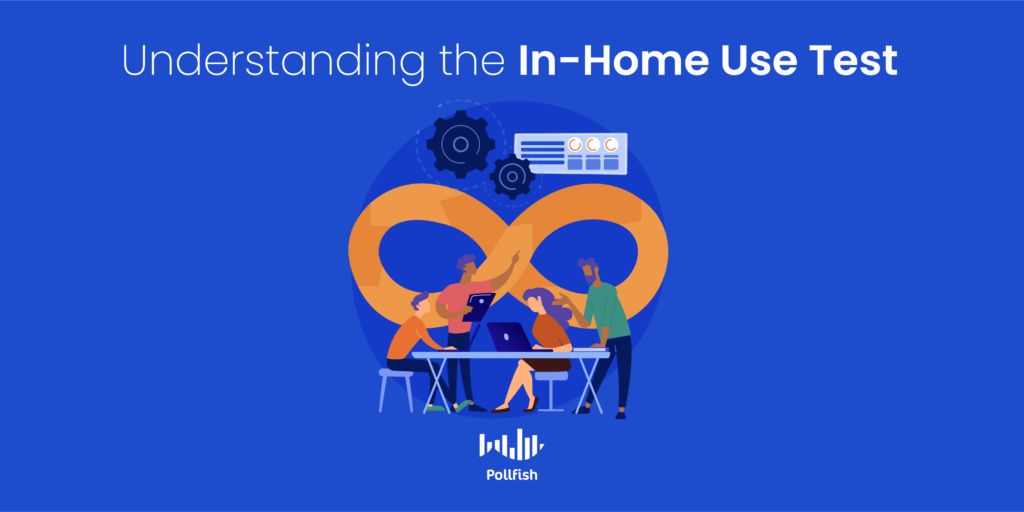
Rather than using the products in an altered environment such as a testing facility, users test the product as they would in their everyday lives. This method removes any biases that occur in unnatural settings and controlled environments.
Thus, market researchers and businesses can understand exactly how their target market interacts with their products before they officially launch new products to the general public.
After using the product(s), the customers are sent surveys to share their opinions and experiences with the new product(s).
When to Use an In-Home Use Test
There are several situations in which using an IHUT is a necessity. They often tie into the need of assuring the success of a product, as opposed to being used with other campaigns, such as branding or advertising.
The most utilitarian purpose of using the home usage test in your market research is to gain honest customer feedback on a product before it gets launched.
Market researchers can also stand to use it for different purposes, which include the following:
- Innovation experiments: refining or updating an existing product.
- Early product development: when a new product idea is not fully fleshed out, sending testers an early version. This allows product developers to decide whether the product is worth continuing to build.
- Gauging a Commonly Used Product: Some products are used every day; researchers can conduct an IHUT on commonly used products to understand their utility, appeal and limitations.
- Recording customer satisfaction over time: Some customers become more satisfied with a product they typically use over time, while others’ satisfaction may be in decline. Then there are those that don’t waver in their satisfaction levels with a product at all.
- Buying intent and buying pains: Market researchers can learn if using a product over time has any sway in their intent to buy, along with their buying pains.
How to Conduct an In-Home Use Test
The following is a comprehensive set of instructions that explain how to conduct an in-home use test. The IHUT involves a process that market researchers can streamline in order to get the quickest results.
This is to say that you do not need to take part in all of the steps outlined below. You may have already performed some of them as part of the encompassing market research process.
- Determine your target market. This can be done through several market research techniques, including secondary and primary research.
- You must use the correct target market sample when conducting any form of market research.
- You may also conduct market segmentation to further split your target market into smaller segments.
- Deliberate whether you need to perform customer development. If so, find the appropriate step in this process to begin sending out an in-home use test to customers.
- If you have several untested products, prioritize the one which needs product testing most urgently.
- It is beneficial to practice product intuition before sending a product out for IHUT. For example, you ought to infer which product will perform or be of best use to your customers based on past experience or research.
- Choose the number of HUT testers you will need to try your product.
- The ideal number is between 10 -100 participants.
- Ascertain the length of the IHUT study; this can involve testing your product for several days- months, depending on your market research needs.
- Obtain your HUT testers by way of recruiting survey panels or via an online survey tool.
- You can also reach out to known customers by way of their contact information. For example, if they made electronic purchases, your business then has access to their names and email addresses. This is true in other situations, such as interacting with an online chat and providing contact information.
- Offer an incentive to your desired testers to ensure that they partake in your in-home user test.
- Deploy your products to the IHUT participants.
- Include instructions on how you require their participation in the IHUT. Remember to make mention of how they are to return the items (if they should) and whether they should take notes of their experience.
- Follow up with your participants if need be, particularly if you’re running a long study.
- Survey your participants by way of mail-in surveys you can send with their products, phone calls or post-HUT online surveys.
- Analyze your findings when you’ve garnered feedback from all the participants in the study.
- Report the viability of the product and determine if it is ready for launch.
- This involves other considerations, such as:
- whether it needs more testing on other segments of your target market
- if a similar product needs testing to be used in comparison
- or if you should pull the plug on the product entirely
- This involves other considerations, such as:
The IHUT Role in Customer Development
As aforementioned, customer development is a step in the IHUT process. However, given that customer development consists of its own framework and methodology, it can also be said to envelop the in-home use test.
As such, the IHUT can be viewed as a step of the customer development process, namely the first step of customer development, that of customer discovery. This step is predicated on understanding customers and their needs, with a focus on the kinds that your company may fulfill.
It involves testing two hypotheses that relate back to the product:
- The problem hypothesis: your understanding of customer pain points
- The product hypothesis: your solution to these pain points
The HUT can also be applied as part of Step 2 of customer development, that of customer validation. It is centered on gaining validation via selling your product, after your target market approves of it from Step 1.
This is to say that although not its primary use case, the IHUT approach can be used in tandem with a product already in the market. Deploying it alongside an existing product is actually useful for three of the points aforesaid in the above section on when to use the in-home use test.
These include gauging a commonly used product, recording satisfaction over time and delving into buying intent and pain points.
As such, the IHUT approach is useful to leverage alongside the customer development process.
Complementing Your In-Home Use Test with Surveys
The in-home usage test is not a standalone practice as it involves more than just sending out products. The core of this test is obtaining customer feedback on a particular product. There are several routes you can take to study customer opinions of an IHUT product.
You can call them directly and have a discussion on their findings. You can also send them surveys along with the products. Surveys allow you to ask virtually any product-related question.
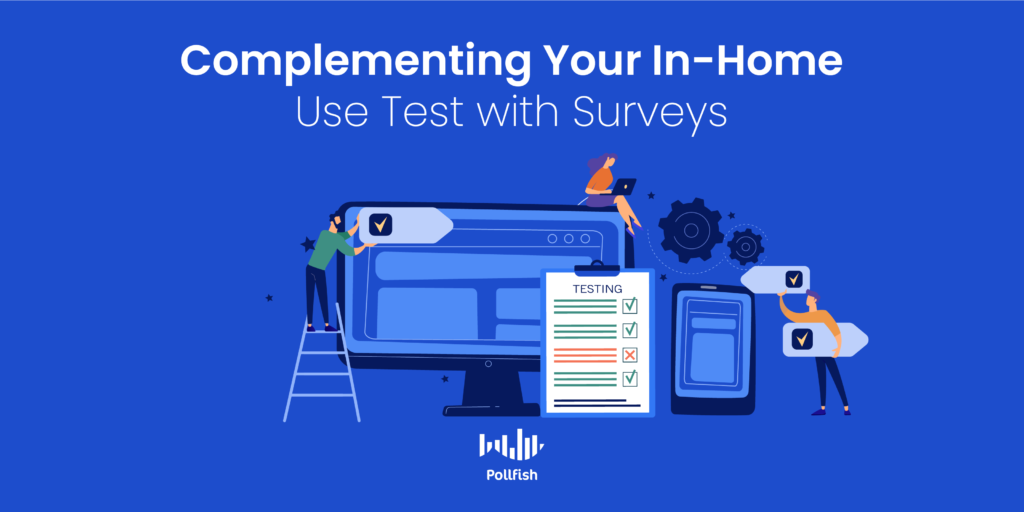
For quicker insights, it is best to deploy electronic surveys, some of which may facilitate various aspects of survey research, depending on the platform you use. These include using advanced skip logic to route your respondents to the appropriate answers based on their answer to a previous question.
If you are running an IHUT alongside an already existing product, you ought to use a strong online survey platform, which can distribute your surveys to the masses and allow you to dictate exactly who gets to take part in them. This way, you are ensuring that only your target market will take the surveys.
Taking this approach also enables you to assess the percentage of your target market that is aware of your product.
Perfecting Your In-Home Use Test with Survey Research
Closing off, an in-home usage test (IHUT) is a valuable market research method. While it is primarily used for testing new products before they are officially launched, such a test can be deployed in all stages of product development.
Survey research perfect IHUTs, in that this is the foremost method of gaining customer feedback and insights. To reap the most valuable insights, you ought to conduct regular surveys on your target market.
Running continuous surveys is an adequate means for gaining a host of customer and business insights, along with a range of market research. This is because you can field surveys for virtually any marketing campaign.
Thus, running surveys gives you continuous insights that not only complement your in-home use test, but perfect it as well. But they must be administered carefully.
To do so, you need to invest in a robust online survey tool, the kind that brings agile data from your target market and allows you to distill your target market down to the smallest segment.
How To Conduct Financial Market Research Like a Pro
How To Conduct Financial Market Research Like A Pro

Financial services providers need to integrate financial market research into their business strategy. This research supplies providers in this vertical with meaningful insights on their target market, market products, and services.
Moreover, this data grants and gives financial services providers a framework for decision-making. As these institutions have to deal with money, there’s a lot at stake for banks and money lending companies.
In 2019 alone, the global financial services industry spent an estimated $50 billion extracting raw data to support their trading activities and transactions.
This is because financial market research data enables them to forecast and analyze any trends or aspects of the organization that needs changes. Not only this, market research offers opportunities for investments that increase the profits for an organization.
Even in 2020, when the pandemic brought the entire world to a standstill and disrupted the global economy, financial market research helped finance leaders and the financial services industry to support the economy’s financial recovery.
The Rising Importance Of Financial Services Industry
As aforementioned, the financial services industry is the main driver of a country’s economy, mainly dominated by large organizations. With a strong financial services sector, the nation’s economy grows, and the consumers earn more, thereby increasing their purchasing power.
The uncertainty brought about by the global pandemic means that potentially every company and organization is likely to make smart and bold financial decisions. Unlike the financial crisis of 2008, the 2020 pandemic has disrupted all aspects of the economy. This means that finance leaders and the financial services industry are strategically positioned to support the economy’s financial recovery.
With the recent changes in technologies, the rise of new investment trends, and the significant shift in consumer behavior, financial services companies are forced to tap into valuable information to approach these changes.
Moreover, companies need to leverage relevant data and insights to make the most of these opportunities to keep up with the recent digitization and innovation in the financial services industry.
This means that market research is as crucial for the finance sector as any other industry.
The Importance of Conducting Financial Market Research
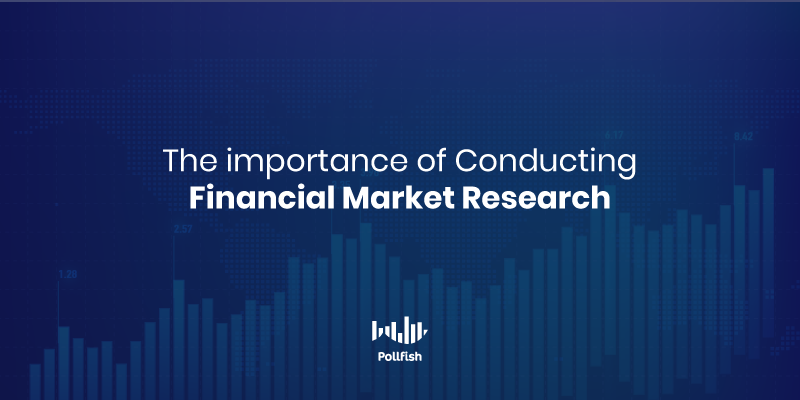
Financial markets play a crucial role in driving a country’s economy and offering countless opportunities for investors to tap into specific markets and services. But with changing regulatory demands and consumer requirements, financial services companies and organizations need unique insights to keep up with this changing industry.
Financial market research is essential because it can help break down market data and trends into a broader context that offers finance companies a clear perspective of the risks and benefits of a particular service.
Therefore, several financial services providers invest in data analytics and market research to gain valuable information about their customers.
However, conducting accurate research is not easy. Lenders, bankers, real estate brokers, and all other kinds of financial services providers need to know precisely what kind of information will help them in decision making.
For commercial banks and investment companies, market research is essential as it determines which business proposition can benefit them in the long run. Moreover, it helps brokerage firms assess which products are in demand by their customer base so that they can suggest them based on the individual requirements of their customers.
The following expounds on why a financial market analysis is important for banks and other businesses for their decision-making process:
Reduced Business Risks
When it comes to investing money, businesses need to know the right time to invest. With financial market research, they can predict the value of their investment to reduce business risks. Developing a financial plan that outlines all the risks and benefits that a firm may incur can give financial services providers an idea of which opportunities to invest in.
Understanding these trends is also important so firms know exactly how to respond to market changes. Some frequent research areas for financial services providers include:
- Insurance
- Business Banking
- Personal Loans
- Mortgages
- Property Management
Effective Forecasting And Analysis
Accurate financial forecasting is crucial for financial service providers to strategize in the face of any uncertainties that may affect their business. Thus, financial market research equips businesses and institutions in their strategic planning process.
This kind of research also provides deep insights into customer behavior and market shifts due to external factors and variations in market trends. With thorough finance market research, supported with effective survey campaigns, businesses can tap into what their customers are doing to offer something unique that sets them apart in the industry.
It enables financial service institutions to set realistic and feasible goals and helps them predict their annual budgets.
Accurate Demographic Targeting
To know their ideal demographic, businesses need effective financial market research to assess their target market and what they require from their business. This kind of research is also useful for understanding the distribution of consumer spending over a particular period and how customers feel about their financial situations.
Financial service providers should inquire of their target market as such: are its members willing to make financial deals with your business at this time of crisis? How have their spending and saving plans changed?
Adequate financial research will delve into all these behaviors and trends at length to help institutions make better decisions. It also provides insights into demographic spending trends, where customers look for financial guidance and receptivity to media.
Internal Audit Assistance
Businesses can evaluate the trading activities, existing credits, and regulatory reports for a successful internal audit by assessing financial market conduct.
The interconnectedness within the financial system has made it necessary for institutions to analyze their vulnerability to systemic risks by assessing and analyzing macro-economic factors, industry trends, changes in regulations, risks materializing at other entities, and innovation by peers.
Carrying out an internal audit for a company offers a detailed report on the market's existing and predicted financial risks. The interconnectedness of different industries and systematic risks in the economy brought about by the pandemic have made it imperative for financial services providers to put forward a dynamic audit plan. And the only way an audit plan will be successful in pointing out a company’s vulnerabilities is with adequate financial market research.
How To Conduct Financial Market Research
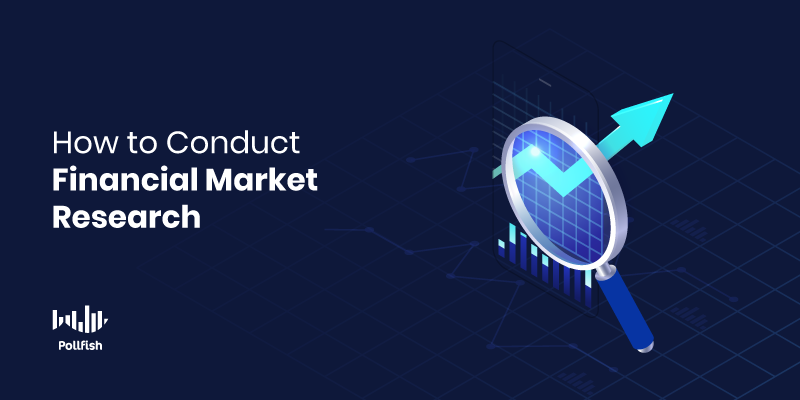
The following are two foremost methods for conducting financial market research:
Primary market research methods for the finance industry
Primary market research for the finance industry involves the direct participation of financial services providers in the research. It offers valuable data on different market areas that providers may require, as obtaining firsthand data provides them with unique insights, particularly their study. This is of utmost importance as secondary research providers do not provide data into the particular inquiries and topics of study that a financial services provider seeks.
Some of the methods to conduct primary market research for the finance industry include:
- Interviews – Financial services providers can hold interviews with industry participants to ask questions that require deep understanding. This is important to assess the changing preferences of clients for different financial services
- Observations – This is a qualitative, no-interaction technique used by financial advisors that can help them gain useful insights regarding the practices followed by finance companies, their competitors, and customer trends
- Email surveys – Financial advisors can contact industry participants and get feedback through a survey that includes short questions. These responses can then be analyzed and compiled as a report to understand market trends
- Online Surveys – They prove to be an essential tool within market research techniques as they collect data and insights on the exact amount of respondents to use in a survey pool. Online surveys can also support a company’s decision-making processes and offer them a competitive advantage through fast quality data. By accessing the right platform for generating online surveys, the financial services providers access qualitative and quantitative surveys.
Secondary market research methods for the finance industry
Secondary market research for the finance industry relies on data and information that researchers extract, meaning that the data has already been conducted by a third party and made available.
Some of the methods to conduct secondary market research include:
- Industry Reports – Industry reports identify any opportunities or risks that the industry might face and present scenarios from the past that can help financial advisors deal with threats in a better way
- Case Studies – Case studies illustrate how industries dealt with financial crises in the past and can provide a detailed, in-depth investigation into a complex situation. They are perfect for providing you with real-life examples of industries and actionable insights
- Statistics sites – Statistical research can help you decide which data collection methods would garner maximum results, what decisions to make, and how to predict behavioral response based on past statistical reports
- Research papers – Research papers provide in-depth knowledge on a particular topic that helps financial services providers understand and make better decisions
- Research agencies – Research agencies know all the proper tactics for conducting market research. They can help financial advisors with information such as client preferences, the right target market, predicting future financial conditions, etc
However, the type of research method financial advisors choose depends highly on time and available data. Qualitative market research like interviews and participant observation offers detailed, rich information and takes some time to collect. On the other hand, surveys and online feedback are easy to collect and lack necessary details.
Secondary Market Research For The Finance Industry
The following is the list of the best secondary market resources on important data and insights on the finance industry.
It offers a general overview of the financial services industry, from money management to digital banking technologies. Also, it outlines all the major trends, topics, and behaviors needed for companies to climb up the ladder in the financial sector.
Includes reports on the latest financial market research and provides analytical data on different financial subjects such as insurance management and consumer spending/saving patterns.
Compiled by IBIS World, this website is a massive database of thousands of industries. It presents useful information on economic changes, demographic data and helps organizations make better financial decisions.
This website provides press releases, publications, and reports on banking and financial services. Given the devastating impact of the pandemic on the financial sector, the reports on MarketsAndMarkets also offer strategic, tactical advice on using financial services to help companies recover from their losses.
The Business Research Company is the most authentic report on the internet that provides detailed reports on different industries in the market. It presents past trends and how markets have changed in the past decade and predicts statistical information on financial services providers.
Financial market research enables the finance industry to gain meaningful insights into different products and services. This increases sales opportunities and offers businesses all the information they need to design effective financial strategies.
Carrying Out Effective Research in the Financial Sector
Financial market research enables the finance industry to gain meaningful insights into different products and services. This increases sales opportunities and offers businesses all the information they need to design effective financial strategies.
Online surveys are the most convenient method for collecting data owing to their accessibility and accuracy. This is why financial services providers need to leverage the power of an online survey platform or market research experts so that they can target a vast audience base and generate reliable survey responses.
To improve data quality, advanced online surveys leverage machine-learning to highlight and eliminate poor quality responses. AI in market research reduces the chances of error and eliminates duplicate entries of data that might result in outdated information and poor data quality.
These online surveys are then used in random device engagement sampling (RDE)to engage a huge customer base on devices they are already using. Whether these surveys are posted on mobile apps or gaming interfaces, they are placed where the business’s audience can easily respond to them. This way, they can tap into unique and high-quality market research data that drives their decision-making process.
Frequently asked questions
What is financial market research?
Financial market research offers useful insights into financial trends and strategies and gives statistical information on the leading finance companies. It also provides actionable insights regarding various financial instruments like portfolio pricing, risk management, etc.
Why do businesses need to conduct financial market research?
Financial market research minimizes the risk for financial services providers and identifies new business opportunities for them. It also gives them insights into market trends, identifies problem areas in the market and untapped resources.
How can an online survey platform help businesses with financial market research?
Online surveys are a reliable way of getting insights directly from consumers. They are also affordable and require minimal to no investment.
What are some of the resources to find secondary research on the finance market?
Secondary market research sources include the web, media sources, industry reports, case studies, press releases, publications, and company compiled data.
Do businesses need a financial advisor?
Even though many business owners choose to conduct their research, financial advisors can offer a solid, strategic plan that takes all their previous, present, and future investments into account and provide them with the most feasible plan. Moreover, financial advisors are experienced in their job and know a lot more about financial market trends than business owners that can help in effective decision making.
Understanding the Customer Acquisition Cost (CAC) and How Surveys Lower It
Understanding the Customer Acquisition Cost (CAC) and How Surveys Lower It
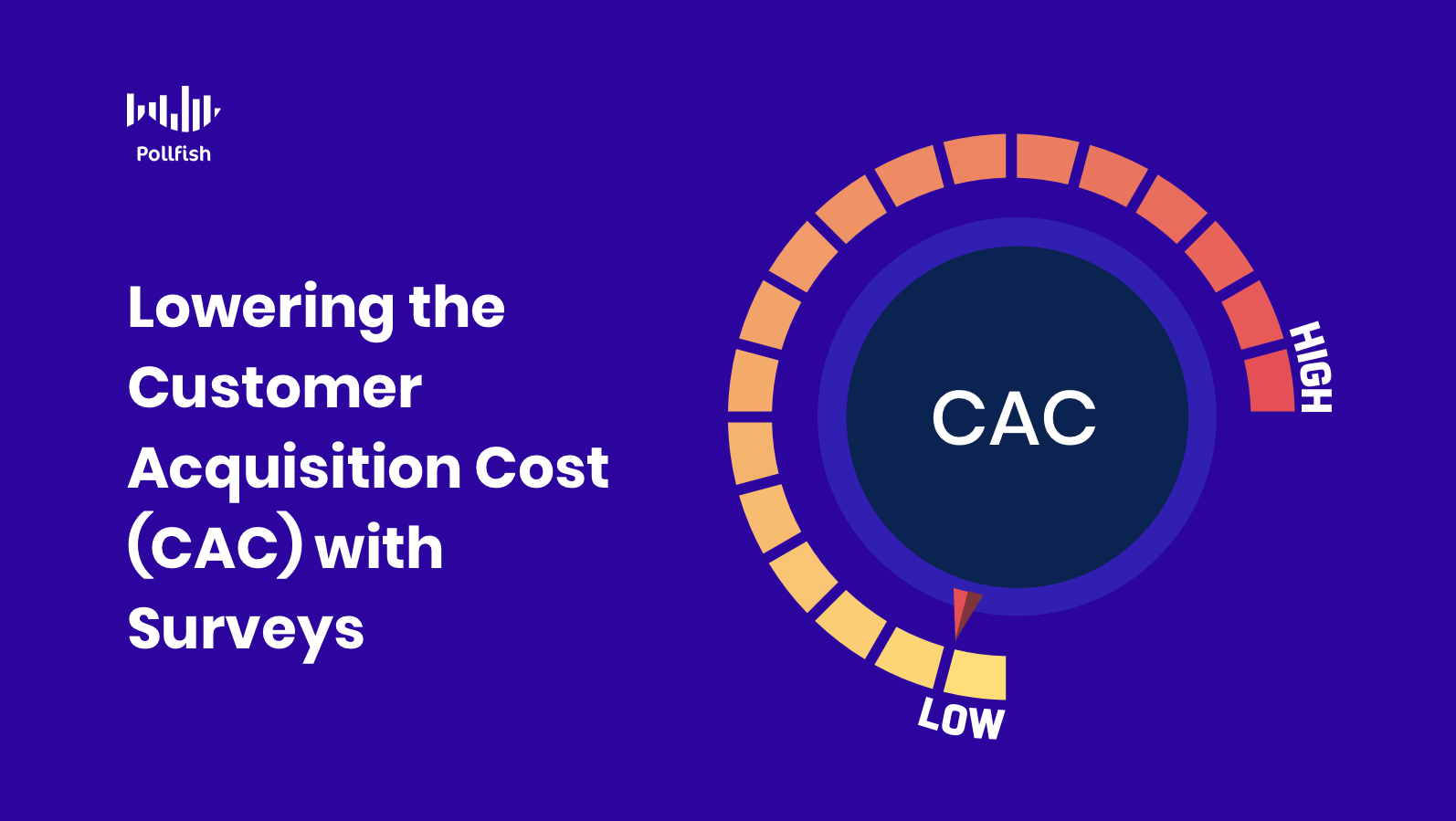
Acquiring new customers can be costly, making it imperative for businesses to understand their customer acquisition cost or CAC. It is especially important to attempt to reduce this cost, given that acquiring a new customer costs five times more than retaining an existing customer.
Companies also need to contend with balancing their CAC with the worth that a new customer brings to their business.
While customer retention carries a larger value, as existing customers are 50% more likely to buy a new product from a business and 31% more likely to spend more per order, attracting new customers still carries weight in sustaining a business.
That is because in order to retain customers, a business must first gain customers in the first place. Additionally, not all customers will become repeat buyers. Thus, acquiring new customers is generally favorable.
This article explains the customer acquisition cost, how to calculate it, its role in a customer’s overall worth, or customer lifetime value (CLV) and how surveys can help minimize the cost.
Understanding the Customer Acquisition Cost (CAC)
Businesses funnel most of their budgets into their target market, whether it is to understand it via market research techniques, cater to it to boost customer satisfaction or make potential customers aware of it through brand awareness campaigns — all in the name of maintaining a steady flow of customers.
As such, businesses work to acquire new customers and the customer acquisition cost measures the monetary value of acquiring them.
The customer acquisition cost is a metric that dictates the total cost of gaining a new customer, taking into account the expenses incurred from sales and marketing.
Essentially, this metric keeps track of all the money that a company has spent attempting to convince a non-customer into becoming a customer — but only when the targeted individual makes a purchase, thus becoming a customer.
The CAC can also refer to the cost of gaining new leads or a new subscriber.
The objective goal of any business is to keep the CAC at a minimum, as a lower customer acquisition cost entails less labor and resources to convert a potential buyer. Additionally, a low CAC creates a quicker gateway to higher profits and revenue.
The Importance of the Customer Acquisition Cost
The customer acquisition cost is critical to track in a business’s marketing budget — but it carries much more importance than just another logistics matter.
Firstly, the CAC is one of the most expensive investments a company can make, as it incorporates a variety of practices and disciplines to reel in new customers. It relies on the following, all of which requires channeling monies:
- advertising
- SEM
- SEO
- content marketing
- event marketing
- social media
- PR
- branding
In addition to the cost of these activities, companies also invest in human capital, many of which are full-time employees, to carry out these activities. Thus, the most expensive aspect of the CAC is employee salaries. On top of that, some employees are also paid a commission.
The CAC is therefore a major investment and businesses must keep continuous track of it. Only by doing so can they optimize it, therefore lowering it, saving money for the business and obtaining leads quicker.
Businesses should also be wary about their cost of acquisition in order to fuel growth. After all, in order to retain customers, you need to have a steady pool of them.
When businesses neglect to calculate their CAC, they aren’t gauging how effective their marketing and sales campaigns are, whether they are gaining more customers and how valuable those customers are for the long term.
Thus, many key aspects of the business follow suit to this kind of negligence, such as ROIs decreasing. A high CAC can also lead to declining revenue, directly impacting a business’s sustainability for the worse. When the revenue continues to decline with no assessments on the CAC and therefore no plans at curbing it, a business becomes at great risk for going out of business.
When and How to Calculate Customer Acquisition Value
Businesses have the option of examining their customer acquisition value within different timeframes. This involves calculating the CAC once a year to understand it on an annual basis, as well as reviewing it at regular intervals.
It is apt for businesses to measure their CAC on a quarterly basis, given the significance of the quarter and that businesses tend to measure the performance of other business activities, such as brand tracking.
Businesses can also calculate their CAC on a campaign-specific basis, should they seek to understand how a specific campaign affects their CAC.

To calculate your customer acquisition cost: first, you must determine the time period to evaluate such as a month, quarter, year, etc. This will allow you to focus your analysis. Then, gather your marketing, sales and all the other expenses used to acquire new customers.
Plug those variables into the following formula:
CAC = (add all costs of acquiring new customers) / the total number of new customers gained during a time period
For example, a jewelry company that spent a total of $3,500 on marketing collateral and mini-campaigns to draw more customers to its online store and gained 100 new customers would have the following CAC.
CAC = $3,500 / 100
CAC = $35
How to Determine a Customer’s Worth with the CAC
Businesses should never analyze their customer acquisition cost on its own. Instead, they must examine it in relation to another critical metric: customer lifetime value (CLV). This indicates the revenue that a customer will generate throughout their entire relationship with a company.
It’s important to weigh the CAC against the customer lifetime value, given that not all acquired customers bring the same value to a company.
The CLV divulges two key aspects of a customer’s value: their revenue value, along with their anticipated lifespan doing business with a company. Thus, the longer a customer purchases products and services from a business, the greater their CLV becomes.
The CLV allows businesses to discover the most significant customer segments in their target market. This is because even a small portion of these kinds of customers add the greatest value to the revenue.
The CAC depends on a decent CLV. This is because the CLV shows whether a business is sustaining an ROI or losing money. For example, if the CLV of your customers is $300 and it costs roughly $900 to acquire them, that means your business is losing money, with a net loss of $600.
For example, if the CLV of your average customer is only $500 and it costs close to $1,000 to acquire them (advertising, marketing, special offers, labor), then could severely be losing money if you’re not able to pare back your acquisition costs and/or increase CLV through other products and services.
It can be difficult to calculate the CLV for a fledgling business, as it does not have a large amount of historical data. However, it is vital to monitor this metric and compare it with the customer acquisition cost.
Businesses can calculate their CLV on a 1, 3 or 5-year basis. If a company is relatively new, it can compute its CLV via subscription renewal rates (in a subscription model) or repurchase rates.
The most important kind of business acumen that examining the CAC against the CLV brings is whether the customers that businesses acquire yield more revenue than they cost.
Customer Lifetime Value to Customer Acquisition Cost Ratio
When a business compares its CAC with its CLV, it must do so via the customer lifetime value to customer acquisition cost ratio, or CLV: CAC, also expressed as LTV: CAC. This ratio reveals a customer’s value, relative to how much it costs to earn the customer.
It helps businesses adjust various expenditures, such as marketing, sales, advertising, UX and more. Additionally, it illustrates whether a business is slated for sustainable growth and can stay ahead of its competition..
A suitable CLV: CAC is 3:1, as it shows the value of customers is three times as much as its costs to acquire them. When this ratio nears 1:1, it indicates that a business is spending the same amount of money to obtain customers as the customers are spending on a business.
A business with a higher ratio, such as 6:1, signifies that a business is not spending as much as it should on sales, marketing and other means of customer acquisition. This can mean that it is losing opportunities to gain more customers.
For example, if a company has a CLV of $4,000 and a CAC of $1,000, the CLV:CAC = 4,000:1,000 or 4:1.
How Surveys Help Lower the CAC
Surveys can help reduce the customer acquisition cost in a number of ways. This is because surveys can get to the heart of who your customers are, thereby allowing your business to better serve them.
Surveys also allow you to better understand your customers in relation to your overall industry. In this way, businesses can then tweak their offerings, experiences and services to your customer’s liking. They also help you avoid the things that repel them, whether it is a specific topic, messaging or price point.

The following enumerates the other key ways the surveys reduce the cost of customer acquisition.
- They help glean a clear understanding of your customer segments via market segmentation. Without understanding the makeup of your target market, you won’t be able to serve your customers or market to them.
- They allow businesses to implement proven marketing/advertising methods via experimental research.
- They track brand awareness and brand equity, as these aspects contribute to customer acquisition.
- They optimize advertising campaigns, so that customers will gravitate towards a business, thereby lowering costs.
- Surveys help you augment your content marketing strategy to draw in customers across the digital space and increase your site traffic.
- They remove any hesitation or guesswork around any marketing campaign or business campaign at large.
- They foster customer development to ensure a product is needed prior to launching.
- They prevent businesses from spending on wasted efforts or unsatisfactory methods of drawing in new buyers.
- For those with lower budgets, they help businesses settle on one marketing effort over another, rather than spending money on both.
- They gauge the customer satisfaction of existing customers, so that businesses understand how to better reach and serve new customers.
Rounding off Any Acquisition Campaign
As the above section expounds upon, surveys help lower the CAC in several ways, in turn allowing a business to save money on acquisition. However, there is far more to a survey campaign than the surveys themselves.
In order to round off any customer acquisition campaign or market research campaign at large, businesses need the power of a potent online survey platform. Such a platform provides all the necessary software to run a quick and efficient survey campaign.
There are various capabilities that businesses must look for in an online survey tool, such as artificial intelligence and machine learning to ensure relentless quality, an automated checking system that disqualifies low-quality answers, survey fraud and survey bias, along with one that offers mobile-first quality in mobile experiences.
A survey platform that offers all of these functionalities and more will set up a business to lower its CAC and excel at all marketing and research efforts.
Increasing the Customer Retention Rate with Surveys
Increasing the Customer Retention Rate with Surveys

The customer retention rate (CRR) is a crucial metric for virtually all industries. As its name suggests, it measures the percentage of customers that a business has retained over a given period of time.
This rate essentially spells out how successful companies are at satisfying and keeping their existing customers. It is therefore a measure of customer loyalty, helping businesses better understand why customers stay with a company.
In turn, businesses can improve their offerings and experiences to increase their customer retention. Retention is a key business concept to uphold, as increasing customer retention by just 5% can increase company revenue by 25-95%.
This article explains the customer retention rate, how to calculate it, its importance, the CRR across industries, and how surveys help increase it.
Understanding the Customer Retention Rate
Customer retention rate (CRR) is a metric that measures a company’s ability to retain its customers over time. A percentage-based metric, it measures how many customers a business retains at the end of a given time period.
For example, if a business has 100 customers at the beginning of the year and has 70 at the end of the year, its retention rate is 70%. (See the section on its calculator for the breakdown of its formula).
This rate is the opposite of churn rate, which gauges the percentage of customers that a business loses over a period of time.
The importance of the customer retention rate will vary based on its industry. For example, businesses that provide subscription-based services (from B2B SaaS to B2C magazine subscriptions) depend on higher customer retention, as it directly affects the profitability of the business.
However, a high customer retention rate is still crucial for all sorts of businesses, as existing customers are 31% more likely to spend more on their average order than new customers. Additionally, retained customers are 51% more likely to try a business’s new offerings.
Thus, maintaining a high customer retention rate should be a top business priority. This involves going beyond measuring the rate alone, but establishing customer satisfaction.
The Importance of the Customer Retention Rate
This metric is important to calculate, keep track of and most importantly, use to raise customer retention. It provides a simple data point for determining how many customers a business retains over time.
It also carries considerable weight in other business matters.
Firstly, studying this rate is important given that it is a major KPI, but unlike many KPIs, this metric relays one of the most sought-after aspects for a business, that of customer retention, as its name implies.
Customer retention, as explained above with statistical figures, offers a wealth of benefits. These include those of relationship-building with customers, forging loyalty and gaining more profits.
Another such benefit is the affordability factor. Given that customer retention is far more valuable for a business than acquisition, one would think it is more expensive to achieve. However, it is anywhere from five to 25 times cheaper to retain an existing customer than it is to acquire a new one. Thus, it is financially more practical and viable to implement customer retention methods.
In order to form such methods, a business must know its standing when it comes to its customer retention, and that is the exact data point that this rate provides.
Additionally, studying this rate, businesses can increase customer lifetime value (CLV), which relays the total monetary value a customer brings to a business throughout the entirety of their relationship with the business. This helps businesses understand which customers and customer segments are the most useful for their business.
By studying your customer retention rate, businesses can improve their ROI and grow revenue, as retaining customers, as laid out in the above figures, is healthy and profitable for businesses. When customers trust a business with their patronage, they provide value, be it with regular purchases or online interactions, such as with social media posts and contributing their own positive reviews.
How to Calculate the Customer Retention Rate

There are several formulas to calculate customer retention rate or CRR, but businesses only need to choose one to narrow down their retention rate. One of the most commonly used formulas uses the following variables and equations:
CRR Variables:
EC - number of customers at the end of a given period
NC - number of new customers during that period
SC - number of customers at the start of that period
Customer Retention Rate Formula
CRR = ((EC-NC)/SC) x 100,
CRR Formula Example:
Let's assume that a business released a new product. At the beginning of Q1, it had 1,200 customers and at the end of Q1, it had 1,400 customers, having acquired 300 new customers within Q1. The CRR is thus calculated as:
CRR= ((1,400- 300) / 1,200)) x 100
CRR= ((1,100) / 1,200)) x 100
CRR= 0.91666 x 100
CRR= 91.67%
Although this is a strong CRR, businesses should remember that it also signifies a percentage of customers lost (normal in business). In this case, the business lost close to 100 customers.
The Customer Retention Rate Across Industries
The average customer retention rate varies across industries. As such, there is no hard and fast rule designating a good or bad rate.
A 100% retention rate is a patently good rate, as it is the highest possible one. Meanwhile, a rate closer to 0%, such as 20%, can objectively be determined as poor. Percentages that run in between these numbers will have different attitudes towards acceptability across industries.
What may work for one industry or niche may be deemed poor for another, and vice versa.
The following provides a rundown of the average customer retention rate across industries:
- Retail: 63%
- Telecom: 75%
- Banking: 78%
- IT Services: 81%
- Insurance: 83%
- Professional services: 84%
- Media: 84%
How Surveys Can Increase Customer Retention Rate

Surveys, especially the online variety, provide a quick and practical means of conducting primary research. While market research techniques include a host of other primary and secondary research techniques, surveys are by every measure, the most proper tools for not simply conducting market research, but to be used as vehicles for increasing the CRR.
Although conducting secondary research is a useful practice, secondary sources do not address specific topics, issues and least of all, inquiries that businesses have about their subjects. Therefore, conducting secondary research alone is insufficient for market research, let alone increasing the CRR.
Companies must incorporate primary research into their market research campaigns, as this method allows businesses to scope out their particular topics and most importantly, their own target market.
To reiterate, survey research is the solution for virtually any market research campaign. Surveys open up the minds of customers’ to market researchers and their respective businesses.
As such, when survey research is carefully conducted and on a potent online survey platform, researchers gain a wealth of customer insights, the kinds that help brands improve their customer experience and overall standing in the eyes of their customers.
When businesses understand their customers on an in-depth level, they can thereby market to and serve them more effectively. Customers appreciate when brands understand their unique grievances and needs, along with the marketing personalization efforts used to better cater to them.
When businesses develop strong relationships with their customers, they build and reinforce customer loyalty, a major component of customer retention. But businesses can only build these kinds of relationships when they understand their customers on a deeper level.
Surveys provide a feasible solution for reaching these kinds of customer insights, allowing businesses to better understand and serve their customers, therefore raising the customer retention rate.
Making Strides in Retaining Customers
A high customer retention rate is an integral ingredient for business success. Businesses must prioritize their CRR over customer acquisition, as customer retention is more beneficial and practical for businesses.
Survey research, as explained above, helps increase the customer retention rate; however, not all surveys are viable for this pursuit. Businesses must choose their online survey platform wisely, in order to ensure they are extracting optimal data and using an agile platform.
A strong online survey platform uses the random device engagement sampling method (RDE) to ensure randomization and obtain respondents in their natural digital environments, along with AI and machine learning for data quality checks, a vast system of survey employment and more. The Pollfish platform offers all of these abilities and far more.
Building Effective Marketing Personalization with Survey Research
Building Effective Marketing Personalization with Survey Research

Marketing personalization is a key ingredient in sustaining a business, as it improves businesses’ relations with their target market on several fronts. 96% of marketers say that personalization helps them advance customer relationships, while 88% said that it had a considerable lift in business results.
Customers themselves prefer personalization in marketing, as 36% of customers believe brands should provide more personalized marketing materials ; however, they are hesitant to share too much information. Thus, the onus is on brands to deliver personalization, but without making their customers feel uncomfortable when performing market research.
There are several ways that survey research solves this problem, so that brands don’t have to choose between the two alternatives of a personalized experience but with intrusive probing, or a non-personalized experience, but without intrusive prodding.
This article explores marketing personalization, its importance, types and how survey research helps businesses execute personalized marketing.
Understanding Marketing Personalization
Also referred to as personalized marketing and one-to-one marketing, marketing personalization is the practice of using data and technology to deliver individualized brand messaging, product offerings and customer experiences (CX) targeted to individual customers.
As its name suggests, this method is an alternative to generic messaging and even the kinds targeted towards particular target markets (albeit broad groups).
This kind of method is also oppositional to traditional marketing, which focuses on the quantity of messages over their relevance. In traditional marketing, brands would cast a wide net of marketing efforts, such as cold-calling, billboards, subways ads, emails and more, but earn a small number of buying customers.
Marketing personalization, on the other hand, is centered on creating personalized messaging relevant for specific people, the kind that doesn’t appear to be mass-produced. It is a means of interacting with customers that feels more human, as it involves their preferences, interests, likes and dislikes and other aspects.
A marketing personalization strategy can include the following examples:
- Customized email marketing campaigns
- Customized social media marketing
- Personalized ads
- Fear of missing out (FOMO) messaging
- Targeted product recommendations
- Tailored content
- Personalized calls with representatives
The Importance of Marketing Personalization
Personalized marketing is critical for a number of reasons. Broadly speaking, it can help businesses optimize a wide number of marketing campaigns and make headway in ROI.
First off, personalized marketing grants businesses the ability to reach specific audiences. Collecting customer data allows businesses to better understand the makeup of their target market. Thus, performing personalization allows brands to perform market segmentation in the process, acquainting and acclimating businesses with their various customer segments.
This allows brands to build more effective email, content and other targeted marketing campaigns. For example, if your market segment likes certain music, brands can use music references in their email campaigns, blog posts, or their email opt-in forms for a more personalized experience.
Personalization also improves the customer experience. CX goes beyond hiring friendly customer agents to assist and engage customers. This is because CX involves all the experiences that customers undergo in their customer journey, from nurture content and emails, to social media interactions, browsing a website, making a purchase and revisiting a brand post-purchasing.
Given the importance of customer experience, businesses ought to personalize their content at any point in a customer journey. 80% of customers are more likely to buy from a brand that offers personalized experiences.
Personalization helps improve content marketing strategy, which is especially important given that content steers many decisions, thoughts and associations with a company. Personalized content marketing makes businesses stand out from the crowd by creating unique and relevant content.
In turn, this creates positive associations with a brand and increases the chances of prospective and current customers returning to a website. This allows businesses to further nurture them, as well as to be continually etched in their minds.
Personalization is also a means for relationship-building, as it creates more personal and stronger relationships with consumers. As such, businesses can show their customers that they care about them, with personalized marketing such as birthday wishes, discounts on birthdays, a personalized rewards system, thank you emails and more.
As a result, personalization boosts customer loyalty, a critical concept for maintaining a successful business, as loyal customers buy frequently, make recommendations about a brand, act as brand advocates, are more willing to try a brand’s new products, along with contributing in other ways.
Given that personalization involves studying customer buying behavior in order to send individualized messaging, it allows marketers to make better product recommendations. Making recommendations is key to pushing conversions, given that they tend to be relevant to the customers' interests and past shopping activity. This is also a key tactic for cross-selling and upselling.
Finally, the most considerable benefit that marketing personalization offers is raising sales and conversions. When businesses grow their customer loyalty and retain consumers through personalized messages and offers, they will be more likely to buy. This idea piggybacks off of the aforesaid figure of 80% of customers being more likely to buy from a brand with personalization. Thus, businesses can count on this tactic to increase their revenue.
The Aspects of Marketing Personalization
There are a number of ways that brands can forge marketing personalization. While the means are plentiful if not virtually limitless, there are certain aspects that form the basis of personalized marketing. Businesses should include these components in their personalization efforts, whenever they are in doubt.

The following lists the key elements of personalization in marketing:
- Hyper-targeted content
- Content that calls out a particular segment, persona and individual customer
- It involves understanding customers beyond their gender, ethnicity and age.
- Specified content
- This content addresses specific needs, desires, behaviors, habits and more.
- It involves prospect-specific news feeds, topics, and content resources/ collections.
- Responsive design
- A kind of dynamic content, which omits setting up individual campaigns, and trying to route customers into the most fitting one, you create a single campaign, (1 email, 1 landing page, etc.) which are presented differently based on the target on the receiving end.
- This brings out the convenience side of personalization, as it is customized for a particular customer. In turn, it will make the customer feel that the company took the time to know him.
- Forging a sense of customer identity.
- Personalized messaging gives customers a sense of identity rather than being treated as another part of the masses. Instead, they are made to feel like unique individuals.
- This solves the grievances of mass marketing, given how often customers are flooded by it, whereas a personalized message treats customers as not just another member of a herd. Thus, the messaging will be more credible.
How Survey Research Fosters Marketing Personalization
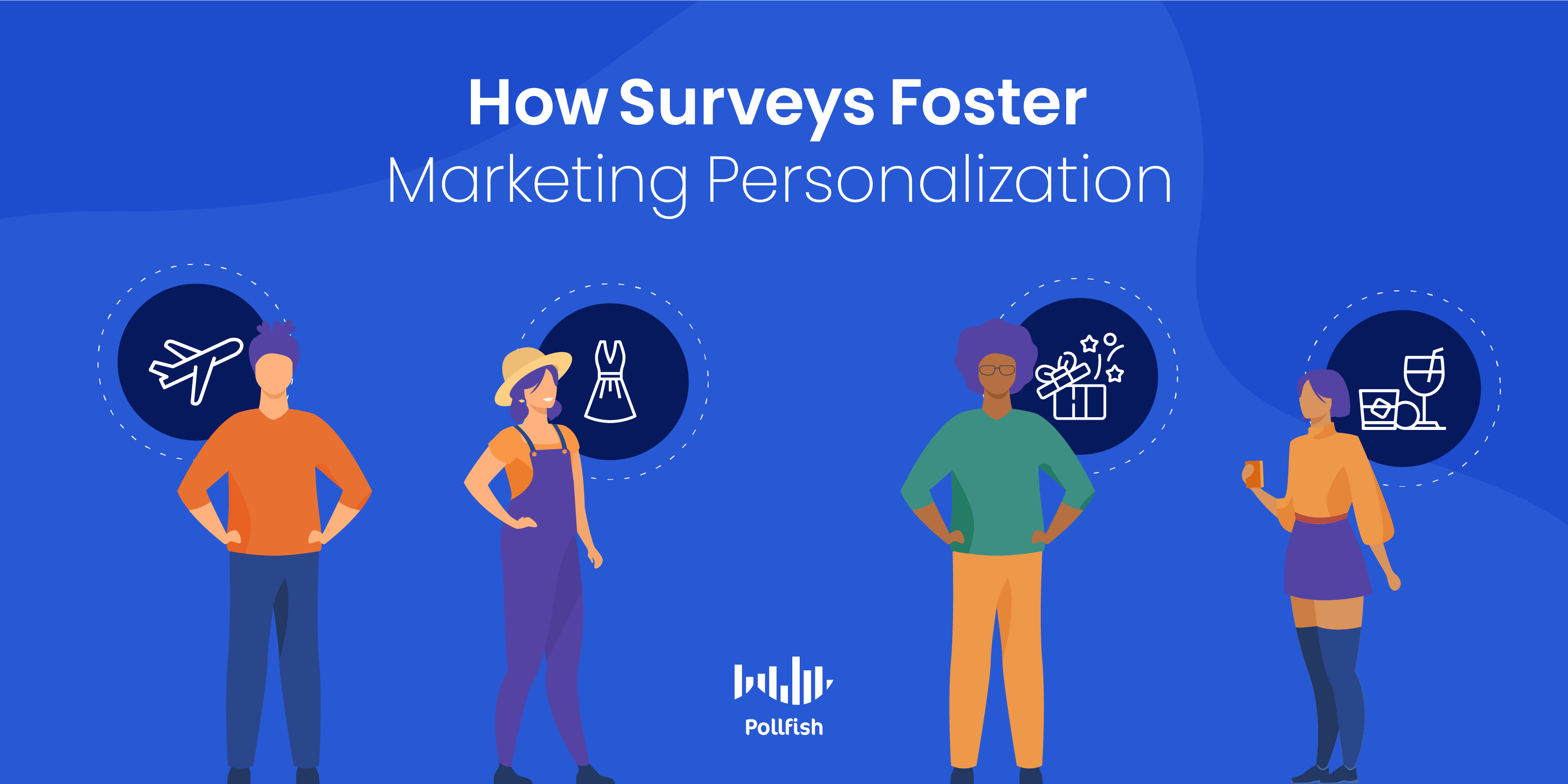
Survey research is an invaluable component of the personalization process. Before creating any personalized marketing campaigns, let alone reaping their benefits, brands must understand their customers as close to an individual basis as possible.
After all, it’s impossible to engage in personalization when you do not know how to personalize. Every market segment iis different, not least every individual customer. What works for one segment or customer, will be ill-fitting for another.
Thus, brands need to establish a firm grasp of their customers’ identities, thereby extracting customer data on who the customers are, what makes them unique and how a business is fitted to cater to their individual needs and remedy their unique pain points.
Surveys obtain the insights into all of these concerns and more. They allow brands to collect better data for decision-making and gain quick access to a wealth of customer feedback. This feedback is useful for gauging existing marketing campaigns, along with setting up new ones based on the intel brands gain on their target market.
Surveys help brands learn the ins and outs of customer behavior, along with gaining valuable insight into the unique characteristics, habits and thoughts of their customers. Therefore, businesses and market researchers should use surveys as the primary means for personalization campaigns and understanding their customers at large.
Taking Personalized Efforts to the Next Level
Customer data is the most valuable thing that businesses can leverage in order to build the most effective personalized campaigns. To do so, they need access to a breadth of customer data; while this may appear to be a feat, survey research makes it easy and practical.
However, not all online survey platforms are built the same. Businesses must bear that in mind and choose their online survey tools wisely. A strong online survey platform allows brands to hyper-target their respondents, set up a number of surveys, deploy the surveys on a large network and ensure the respondents are chosen via randomization — something that random device engagement sampling (RDE) makes possible.
The Pollfish platform offers all of these capabilities and more to ensure that market researchers are obtaining the highest quality of data for their personalized marketing campaigns, along with all others.
Syndicated Research Vs Custom Research: Which is Most Ideal for Businesses?
Syndicated Research Vs Custom Research: Which is Most Ideal for Businesses?
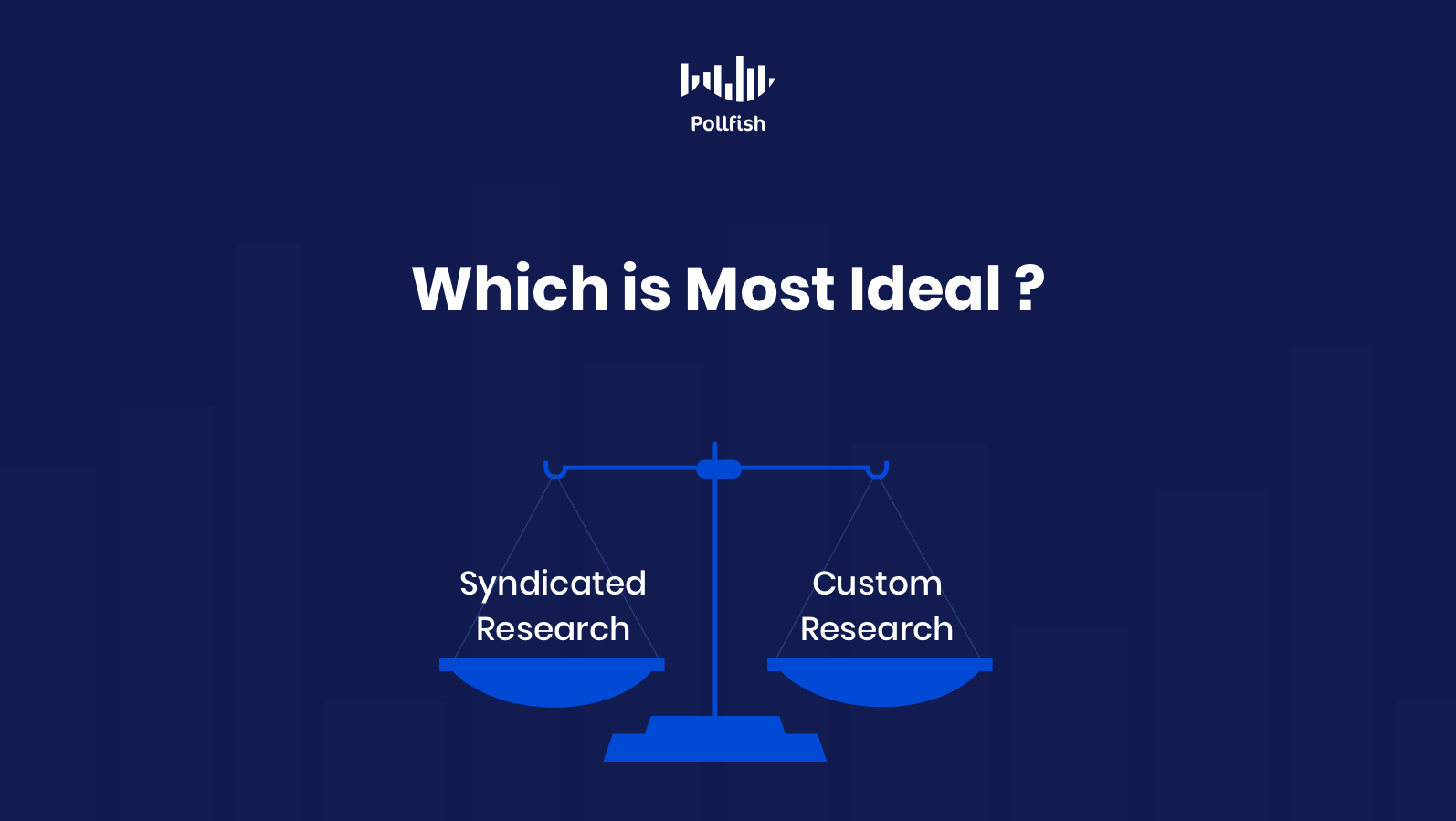 When tackling market research, businesses have the option of using syndicated research, custom research and a slew of other kinds of research providers.
When tackling market research, businesses have the option of using syndicated research, custom research and a slew of other kinds of research providers.
When it comes to steering your business forward, market research techniques provide a vast array of insights into your target market and industry at large. While secondary sources can provide critical information, it is even more important to conduct primary research, which grants unique and updated data that informs your business on a variety of matters.
Thus, researchers are often presented with using either survey panels, syndicated research or custom research as the foremost methods of conducting market research.
This article lays out the key aspects of syndicated research and custom research, along with their differences, so that businesses can informatively choose their best-suited market research method.
Understanding Syndicated Research
Syndicated research refers to the kind of research that is conducted independently, published and sold by a market research firm. This kind of firm is usually industry-specific and is therefore funded by several companies within a particular industry.
Thus, the market research firm and its partner companies own the data that the firm conducts. Other companies within its particular industry may be interested in obtaining the data and can thus patronize the firm.
The firm publishes the data to those who intend to purchase it — other companies within the space, as aforementioned. The data becomes available in the form of presentations, reports and times, as a raw collection of data.
Unlike custom research, syndicated research involves the market research firm and its collaborating companies — those that jointly funded a research project — as the sole owners of the data. This means that companies that purchase the data via syndicated research do not own the data.
In this form of research, the market research firm dictates the subject of the study, along with its direction. The patronizing companies can request additional questions to be added to the firm’s interview, or to have the study extended in some way or another, whether it involves adding a more diverse survey sample or more participants.
Thus, despite the firm’s ownership of a market research project, its purchasing customers have the option to customize it and change it to suit their research needs.
The Key Aspects of Syndicated Research
Syndicated research is characterized by several traits that define and distinguish it from custom research. The following lists several major aspects that form the basis and composition of syndicated research.
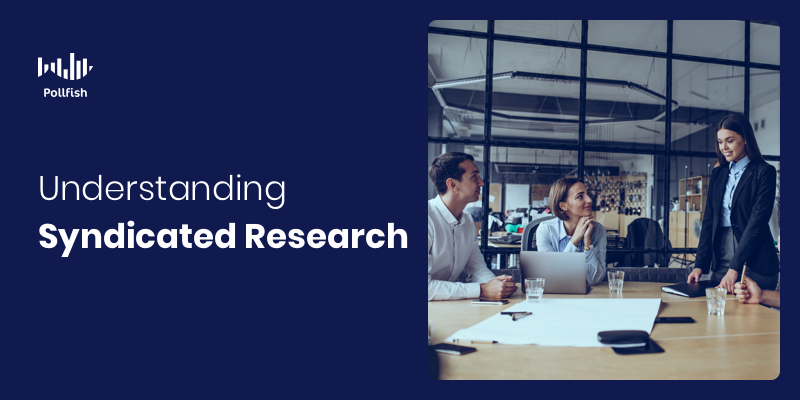
- The market research firm conducts the data and is funded in collaboration with other companies that also own the data.
- The scope, direction and methodology of the research is determined almost entirely by the research firm (although purchasing companies can make requests).
- It allows companies to gain access to general data on the state of a specific market.
- The costs of syndicated research are shared.
- The results provided are the same, so there is no exclusivity among any of the parties involved.
- Since purchasing companies do not conduct the research, syndicated research is considered secondary for customers.
- However, it is primary research for the firm conducting the research.
- It often uses large sample sizes and exits as quantitative research.
- It is often conducted within exploratory research, given that is used as an early form of research.
- A syndicated research firm can specialize in research in one industry or cover multiple industries.
- It is not funded or created for one specific client.
- It allows businesses and researchers to discover information about a market before taking on a full-scale market research campaign.
The Advantages and Disadvantages of Syndicated Research
Syndicated research offers its share of benefits to researchers and businesses alike. However, it does not come without several drawbacks. When deciding between syndicated and custom research, businesses ought to review the following.
The Pros
- Cost-effective, timely and cheaper than ad-hoc research.
- It provides a primer into market research within an industry, given that the information is general and not particular to a niche or company.
- It helps companies identify key trends and the main issues surrounding their industry.
- It uses large sample sizes, which is fruitful for forming predictions.
- It offers competitive intelligence within an industry.
- It assists companies with brand awareness and brand tracking should they make this request to broaden their data.
- Ideal to use for a research thesis, or need to create an investor pitch from various data providers on short notice.
- It can improve the visibility of a company by using syndicated research for amplifying publicity.
The Cons
- The market research firm wields almost complete control over the study, its methodology and direction.
- The acquitted data is too broad and doesn’t address the specific needs that vary from company to company.
- The data can be available for purchase by competitors.
- Investing companies cannot claim full ownership of the research, given that other companies fund it and the research firm is at the helm.
- Although it is an ideal starting point in market research, it does not cover the many unique aspects individual businesses will need, especially when brand tracking is concerned.
- The data does not provide granular insights for research beyond exploratory.
Understanding Custom Research
Custom research is a kind of research that is conducted for and funded by one company — the client, who owns the resulting data. Market research companies run the campaigns and provide the data, made custom for the client.
In custom market research, the company, namely the client that procures the data has control over the campaign, thereby controlling the participants of the survey, the questionnaire, the quotas and virtually all else. In this regard, custom research fulfills its name, as it is customizable according to the client’s needs.
Custom research ensures that the client company dictates the requirements of a research campaign, sets the participant qualifications and meets all of its specific needs. When a company seeks information that closely aligns with its unique business aspects, it is ideal for it to turn to custom research.
Thus, custom research is better suited for handling research beyond the early stages, such as exploratory and explanatory research. It is also more fitting for obtaining a more in-depth analysis of a target market since the client company can format a survey campaign to its liking to fit its precise needs.
Both client companies and individual researchers are not obliged to share their insights with any other entity, nor do they have to publish their insights, although the latter is used for thought leadership, therefore making custom research ideal for content marketing strategy.
As for the former, the insights brands derive from custom research are completely unique to them and no other company can claim them as theirs, as the client company owns the data.
The Key Aspects of Custom Research
Custom research features several aspects that differentiate it from syndicated research and shape its experience. The following lays out various major components that form the offerings of custom research.
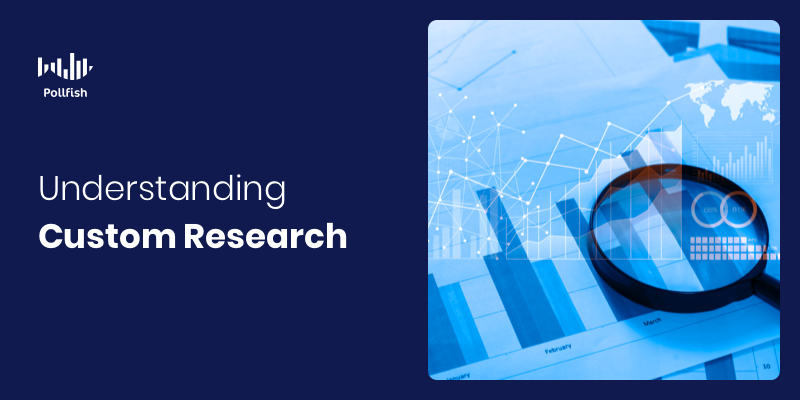
- It is produced specifically for one company, rather than being a joint effort by multiple companies.
- Although a market research firm provides the means of conducting the research, the client company owns the extracted data.
- Custom research is suitable when a company requires more precise data about something specific to its business.
- It is conducted after the early stage of the research process, for example, during descriptive, correlational and experimental research.
- Custom research can provide clients with industry benchmarking, trade dynamics, segmentation analysis, economic impact and more insights.
- It allows clients to take control of the direction of the research campaign.
- Market research firms either conduct the research themselves or provide a tool for the clients, who then conduct the research themselves.
- For example, an online survey platform.
- It incorporates a client-centered approach, thus the insights are particular to the client and their customer intelligence needs.
- This kind of research allows companies to customize any aspect of the research, from qualified respondents, to the number of respondents, to question-formatting.
- The market research firm has no sway over a market research project as it would in a syndicated research project.
- The client company is the sole proprietor of the data, but must also fund the research project on its own.
The Advantages and Disadvantages of Custom Research
Custom research has various advantageous qualities that complement a market research project. However, it also has a few downsides. Businesses and market researchers ought to understand both before embarking on a custom research project.
The Pros
- It is ideal to use when a company requires in-depth information about a particular target market segment, or an issue unique to the company.
- Businesses do not have to share the resulting data with similar companies, making them more equipped with insights than their competitors.
- This allows companies to extract only the information they need, avoiding information overload and having to parse through unneeded information.
- It provides hyper-targeted Information so that businesses can improve on a number of fronts.
- Researchers ideate individual questions and use all the ones they find necessary for their business’s particular needs.
- The data is much cleaner and easier to analyze when it concerns one business’s specific matters.
- Businesses gain deeper insights rather than broad generalizations that can be applied to multiple companies, reinforcing the strength of qualitative and quantitative insights.
- It offers an additional layer of insights that syndicated research cannot find.
- Market research firms often provide different pricing plans for businesses, so that even those on a budget can implement custom research.
- It can be used as an extension of a syndicated research project, or as the missing piece to other secondary research.
- Custom research is tailored to a company’s specific needs, thus the insights are more applicable and actionable when a company seeks to make changes.
The Cons
- This kind of research is the costlier option as it is funded by only one company with the research tailored specifically to the company; thus it bears the burden of paying a full price, one that is more expensive than it would be in syndicated research and other joint projects.
- It takes more time and effort to conduct from a logistical and planning perspective.
- It must be performed by a market research company, if not, it carries too many risks, such as survey biases and incomplete information.
- Researchers are left to fend for themselves when it comes to ideating the project and its needs.
Which Research Method is Most Ideal for Your Company?
When choosing between syndicated research and custom research, a business must consider all of its market research needs: from the highest priority to the lowest. It must also consider the campaign for which it needs the research.
Critical inquiries to consider include: does your budget better fit with the syndicated research model or can you afford custom research? Are there already available insights on the subject you seek to study? If so, how much primary research does your study require?
When a business is at a critical point in its journey, one that requires immediate and actionable insights, custom research is the objectively better choice.
This is because unlike syndicated research, which provides general answers and those that pertain to various companies, custom research provides granular information as specific to a particular company as possible.
Thus, there are little to no questions or hesitations that follow custom research, as the researchers can design the questions and other key aspects of the research campaign to their exact liking. On the other hand, although syndicated research provides valuable data, it is not only too broad, but it can be lacking when it comes to the intelligence needs of a business.
Thus, businesses ought to choose a custom market research provider wisely. A strong online survey platform performs custom research with the prowess of artificial intelligence and a global presence of support.
How to Conduct and Perfect an RFM Analysis with Survey Research
How to Conduct and Perfect an RFM Analysis with Survey Research

An RFM analysis continues to remain relevant in the present day of big data and automation, despite being born in an age where direct mail was the most effective method of communication.
Although its origin traces back to 1995, the RFM analysis is still a valuable method for performing customer segmentation, building customer personas, improving marketing efficiency and executing other applications.
Thus, market researchers should develop an analysis on the RFM model, as part of their market research techniques and to understand the value of various customers.
This article explores the RFM analysis, its importance, scoring system and model, how to conduct it and how survey research completes the process.
Understanding the RFM Analysis
An acronym for recency, frequency and monetary value, RFM is a model for customer behavior segmentation. Also called RFM segmentation, this technique is used to analyze and estimate the value of a customer based on the three data points in its abbreviated title.
The idea underpinning this kind of analysis is to segment customers based on the three major factors that make up customer buying behavior.
This way, market researchers and business owners can identify which customers are regulars, big spenders and those who make one-time purchases. This kind of analysis allows businesses to distinguish between their different customers in this way, but on a larger scale.
The RFM analysis model assigns each customer numerical scores based on the three measures to provide an objective analysis of their value to a company.
The system uses a scoring system that allows businesses to identify 64 kinds of customers (more on that in a below section). The RFM system allows market researchers to segment customers by assigning them scores based on the three data points of recency, frequency and monetary value.
These scores, in turn, allow businesses to understand the value of their customers, whether they are worth pursuing and nurturing and how to better engage them.
This analysis is based on the marketing adage stating that 80% of business comes from 20% of customers, which is also known as the 80-20 rule.
As such, the RFM segmentation model provides a quantitative method for gaining a meaningful impression of customers.
Recency, Frequency and Monetary Value
Marketers and market researchers should be well-acquainted with the three data points comprising the core of the RFM model. All three of these measures are proven to be effective predictors of the various personas’ willingness to engage with the messages in different marketing campaigns.
The following explains the meaning behind each measure and their unique KPIs:
Recency
This measure deals with the following: When was the customer’s last transaction? When was the customer’s last engagement?
Recency is usually expressed in days from the last purchase as its primary metric. However, depending on the product, it may be measured in hours, weeks or years.
Customers who made a purchase recently are more likely to have a product and its brand on their minds and are also more likely to purchase or use the product again.
The KPIs of recency include:
- Date of the customer’s last purchase
- Date of the customer’s last engagement (ex: site visits, conversation with reps)
- Date of the customer’s last activity (ex: logins, in-app usage, commenting)
Frequency
Frequency is concerned with the following: How often did a customer make a purchase within a given period of time? How often did a customer visit a store?
Aside from the physical space, this measure is also used to rate activity in the digital space, such as page visits, unique number of sessions, total logged-in time, time spent on site, time spent on a page, etc.
Customers who purchased once are more inclined to purchase again. First-time customers are good targets for follow-up advertising to retain them and convert them into frequent customers.
The KPIs of frequency include:
- The number of sessions/ visits
- The number of click-throughs
- The number of conversions
Monetary Value
This value answers the following: How much money did the customer spend within a given time period? What is the total revenue generated from the customer?
Not all businesses are ecommerce, such as news sites or content sites (blogs, social media, etc.); therefore, they cannot measure monetary value much like a traditional business would. Instead, they can assign an engagement metric that they deem valuable.
Customers who spend a lot of money yield the most profit for a business. They are also more inclined to spend money in the future, more so than those who have spent less. These kinds of customers bring a high value to a business.
The KPIs of monetary value include:
- Total Revenue
- Average Order Value (AOV)
- Engagement Metrics- Useful for two-sided business models that don't directly sell products.
The importance of Conducting an RFM Analysis
An RFM analysis is crucial for businesses to conduct for a number of reasons. Firstly, it informs businesses on critical customer behaviors and allows them to build customer personas by ranking and grouping customers quantitatively.
As aforementioned, this kind of analysis helps businesses predict how willing customers will be to engage in marketing messages and new offers. However, this kind of analysis can help with several other fronts.
Conducting an RFM analysis gives businesses the opportunity to increase their sales. This is because using this data for decision-making allows them to understand how customers feel, think and shop, and most importantly, what fuels their buying decisions.
The RFM model allows businesses to support personalization efforts, which includes creating more personalized marketing campaigns or website and in-app experiences for logged-in customers. This in turn increases engagement, as it provides relevant messaging and offers to the current customer persona or group.
This helps improve upon conducting a cohort analysis along with increasing retention. In terms of the former, an RFM analysis helps provide more info of customer behavior within different cohorts. As for the latter, personalization allows companies to provide more tailored experiences and messaging — the kind that can resonate more strongly with customers, thereby retaining them, either via engagement or keeping the business on their minds.
Finally, RFM segmentation plays a role in customer retention, which is of the essence for any business. Although customer acquisition is important, retention carries even more weight for businesses, as existing customers are 50% more likely to try a business’s new product. In addition, 9% of businesses lose customers when they don't take customer retention seriously.
When products, services and experiences are personalized and engaging, customers are more likely to remain patronizing a business. Thus, the RFM model contributes to customer loyalty.
The RFM Model and Scores
The RFM model segments customers based on a scoring system.
Each data point — recency, frequency and monetary value — is typically assigned a score of 1 to 5. 1 is the lowest score, signaling a poor ranking of the data point, while 5 is the highest and signals the most positive ranking.
An RFM cell is the collection of the three values for each customer. Companies can average these values together, then sort their customers from highest to lowest to identify the value of each.
Using this scale, each customer can have a score from 111 to 555, with a total of 64 possible combinations, or 64 customer personas from just three points of data.
The scaling systems used in different companies that perform an RFM analysis will differ. Some will use a scale of 1-4, while others may elongate it to 1-10.
Examples of Personas Based on Their RFM Scores
Given the numerous customer personas that businesses can uncover after performing an RDM analysis, there are several key personas they ought to understand. These personas have critical consequences for businesses.
The following lists several major customer personas that an RFM segmentation brings to light, along with the most appropriate marketing campaign to target them with:
The Brand Champion (R=5, F=5, M=5)
This persona represents the ideal customer, as it exhibits the highest possible RFM cell, which is a representation of the 3 scores. When customers are correctly nurtured, they can become brand champions, spreading positive feedback about a business, thereby bringing more customers to a business themselves.
Marketing campaigns for this persona: exclusive offers, pre-purchase of new products, premium customer support, refer-a-friend bonus
The Loyal Customer (R=4, F=4, M=3)
Also a top-tier customer, as this persona visits or engages with a business frequently and has recently bought from them. Although their monetary value is in the mid-range, they can become a loyal customer — with the proper offers. There are several things marketers can do to increase their customer lifetime value or CLV.
Marketing campaigns for this persona: Loyalty campaigns, volume discounts, brand messaging showing the effectiveness of a product
The Possibly Alienated Customer (R=1/2, F=3/4)
This customer has been a regular at some point but has stopped buying recently, revealing a possible alienation. Their needs may have changed or they may have had a poor customer experience. Brands should nurture them back into becoming regulars, as a low recency score can quickly affect their frequency permanently.
Marketing campaigns for this persona: Customer satisfaction surveys, welcome back offers, more ads on their typical products/ services
The New Customer (R=4, F=1)
This persona has recently discovered a business and has engaged or purchased from it. They may also have been customers at some point, but stopped doing business for an interim. Businesses should foster relationship-building with this kind of customer, as they are new or possibly made a one-off purchase after an interim of no purchases/engagement.
Marketing campaigns for this persona: Email list sign-ups, introductory offers, hints, tips, useful content, social media offers
The One-Off Big Spender (R=1, F=1, M=4)
This kind of persona spends a lot of money on a one-time purchase, but then doesn’t return to the business, or does very rarely. This points to a specific need at a specific time, as they made a significant purchase, but only once. Marketers can target this persona by sending them messaging that is hyper-focused on their needs and interests.
Marketing campaigns for this persona: Upgrade and maintenance offers, new promotions, content based on their interests, surveys
The Expired Lead (R=1, F=1, M=1)
The lowest-scoring customers and least viable kinds of customers, they don’t have a significant purchase history with a business and also score low on recent interactions. Businesses should not focus marketing campaigns on this kind of customer, as they are unlikely to bring any value to the company. These are also the weakest to turn into semi-regular customers.
Marketing campaigns for this persona: Awareness-stage messaging, content marketing, automated emails, along with some of the ads used for more valuable customers.
How to Conduct an RFM Analysis with Survey Research
When it comes to performing such an analysis, survey research is not a secondary task. It is a crucial part of identifying each customer via the RFM model. This is because surveys allow market researchers to ask their target market virtually any question.
The key is having access to an online survey platform that offers deployment across all geographical areas in which your customers reside, and ensuring that only the targeted population takes part in the survey.
Given that the RFM model only uses three data points, the bulk of the survey is going to be the three questions on those measures. When conducting such a survey, businesses can also execute competitive research — by asking these questions in relation to their competitors.
This can also help obtain a general idea of how customers shop. Researchers can do so by asking their customers about recency, frequency and monetary habits in the general sense, that is, without mentioning their brand.
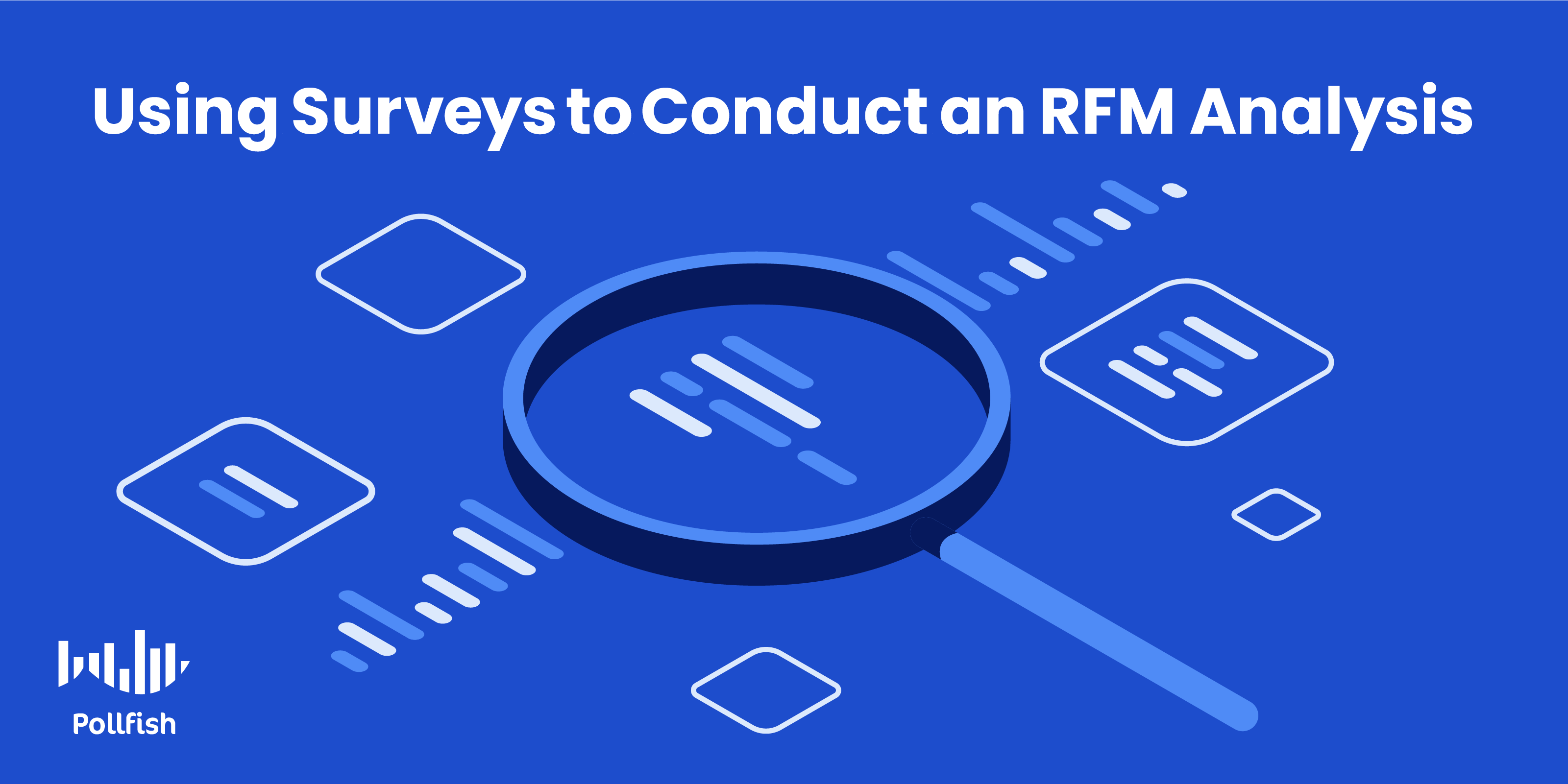
As such, they can also ask supporting questions to better understand each of the RFM data points.
The following lists major and supporting question examples for an RFM analysis in the general sense:
- RECENCY: When was the last time you bought shoes?
- Supporting questions:
- When do you intend on buying shoes again?
- Are you looking to buy shoes anytime soon?
- FREQUENCY: How often do you buy shoes?
- Supporting questions:
- How often do you buy shoes in the winter?
- Do you intend to buy more shoes in the coming month?
- Is there a specific retailer or brand you prefer, or do you buy from several?
- MONETARY VALUE: How much do you typically spend on shoes?
- Supporting questions:
- Are you willing to pay other amounts for different kinds of shoes?
- Which brands do you typically buy from?
- Is price an important factor when picking out different shoes?
Surveys provide a practical means of asking all of these questions and more. With advanced skip logic, brands can route respondents to follow-up questions based on the answer a respondent gave to a preliminary question.
Finding the Most Valuable Customers
An RFM analysis helps you to define some critical customer personas based on three major customer behaviors. But without an online survey platform, performing such an analysis becomes an almost impossible feat.
The correct online survey platform will enable businesses to reach a wide network of customers in their target market, ask them any type of questions and use artificial intelligence to stamp out low-quality answers and survey fraud.
It will also help market researchers hone in on their RFM-based customer personas with additional data. Thus, businesses ought to choose the proper online survey platform to conduct an effective RFM analysis.












